

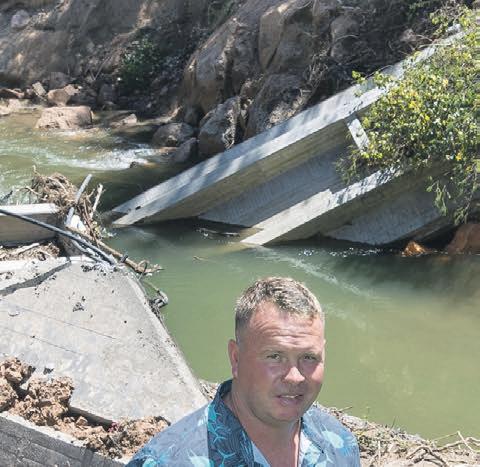

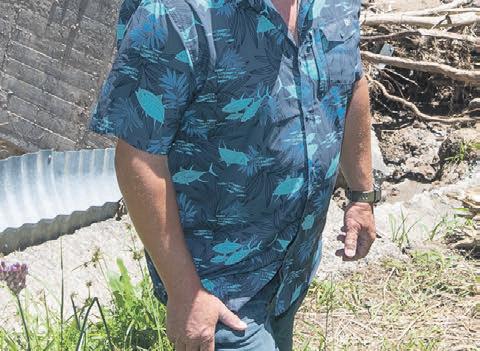







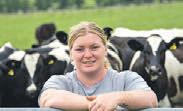





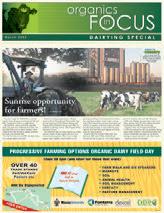
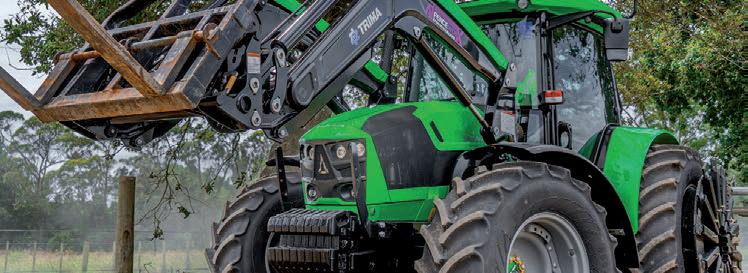






























Pasture Renovation PG 8-9 Rural Homes PG 16-18 Country Lifestyle PG 19-23 Avocados PG 24-27 Dairy PG 30-34 Ben and George Muir at the site of the No 4 Rd bridge washout near Te Puke. ey stand to lose millions if access is not restored to their properties in time for the kiwifruit harvest. Read the full story on page 4-5. Photo: John Borren. WE HAVE NO INTEREST WITH IMPROVED PRODUCTIVITY FINANCE FROM 0%* INTEREST 5 SERIES *Terms, conditions and normal lending criteria applies. 30% deposit, 0% interest rate, monthly payments over 24 months. GST paid month 3. While stocks last and for a limited time only. deutz nz Power Farming Whakatane | 2 Mill Road, Whakatane | 0800 77 88 99
Growers and farmers are facing a monumental task ahead of them following the destruction left by Cyclone Hale and Cyclone Gabrielle.

Both weather events have a ected the North Island severely and the government has allocated a $25 million fund to help farmers and growers in cyclone hit areas.


Growers can access grants of $2000 per hectare, up to a maximum of $40,000, to remove silt from trees and vines, support their clean-up e orts, and minimise tree and vine losses.
Grants of up to $10,000 are available for pastoral and arable farmers to help with their initial recovery, such as repairs to fencing or water infrastructure for stock.

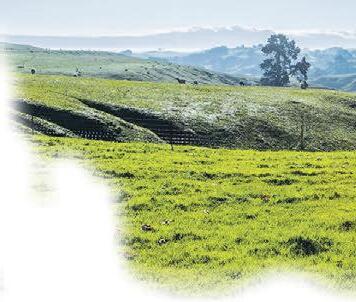

Details on how to apply can be found on the Ministry of Primary Industries website.
Farm support
Farmers, growers and whenua Māori owners needing immediate support are encouraged to
contact sector groups or their local Rural Support Trust.

Other groups people can contact include, DairyNZ, Beef and Lamb New Zealand, Federated Farmers New Zealand and Horticulture New Zealand.







Farmers can freephone the Rural Support Trust on: 0800 RURAL HELP (0800 78 72 54).




Feed coordination service




MPI and Federated Farmers have restarted the national Feed Coordination Service to support farmers recovering from the cyclone.
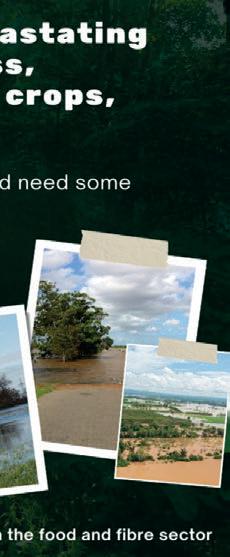
e service helps match people with grazing or supplementary feed for sale to those who need it. To o er or request feed or grazing, freephone: 0800 FARMING (0800 32 76 46).
People can also visit MPI online for more information.


ere are many other services and support available for people in the rural community. See more in this edition of Coast & Country News to see what is available.
SUSTAINABLE FENCING







Page 2 COAST & COUNTRY NEWS www.repost.co.nz customerservice@repost.co.nz
repostnzrepostnz
LOW-COST
‘Our hearts go out to all of you affected in these dif cult times’
Trimmed Half Rounds unpointed 1.8m $3.85 $3.25 1.6m Quarter Rounds unpointed $4.00 1.8m $3.25 1.6m We also provide pointed posts Prices exclude GST 5% discount to all those a ected by the cyclones on orders over 1000 posts DURABLERECYCLED LOW-COSTNZ MADE SMARTINNOVATIVE Our posts meet the NZ H4 CCA treatment standards
Greg Coppell and Stu Dudley, Repost
Many people have been a ected by the recent weather.
Photo: John Borren.
Cyclone Gabrielle: $25m fund to help

been declared.
“ is is an unprecedented weather event, which for some rural communities comes just weeks after ooding in the upper North Island and damage caused by Cyclone Hale,” says Rural Communities Minister Kieran McAnulty.

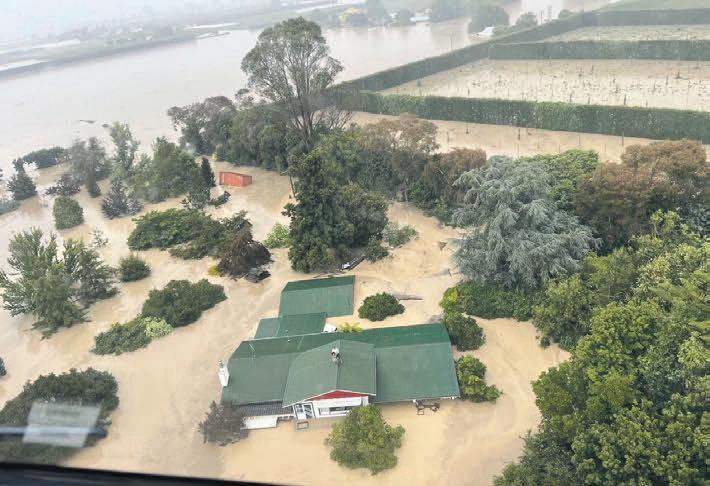
“ e MPI Rural Communities and Farming Support, On Farm Support, Animal Health and Welfare, and Māori Agribusiness teams are on the ground in the regions helping where they can.”
Associate Agriculture Minister

Meka Whaitiri says regional sta from MPI were focused on assisting the primary sector.
“We’re being regularly updated on the wellbeing of people and the welfare of their livestock.
“We will work directly with sector groups and organisations, including Rural Support Trusts, to identify and focus help to the areas of greatest need.
“Māori agribusinesses and their sta have been a ected across the motu and we will help them get through this.”
The Ultimate Swim Spa
Grants from a $25 million fund will help farmers and growers in cyclone hit areas with the monumental task ahead of them, following Cyclone Gabrielle.
e $25 million dollar package is part of the initial $50m of support announced by the government last month for businesses and the primary sector, says Agriculture Minister Damien O’Connor. Read more on Pg2.

Knowledge & support
“Farmers know their farms best, and this grant will help them to direct the money where it will help most



“ is is a di cult time for many, with thousands of people’s homes and businesses a ected by this large-scale adverse event - the Government is here to provide support.
“I expect we will provide more support once a full and thorough assessment of the damage caused by Cyclone Gabrielle across the North Island is complete.
“ at destruction includes ooded farms and orchards, damage to vital roading and electricity infrastructure, and isolated communities.”
Conditions following the storm in February made it di cult to assess the full extent of crop damage, livestock losses, and disruption.
Widespread power outages also a ected dairy farmers’ ability to milk cows, especially in Northland.

Ministry for Primary Industries sta have been

working closely with sector groups and processors to minimise any potential animal welfare issues.

“It’s expected damage caused by Cyclone Gabrielle will exacerbate feed issues experienced by some farmers in ood-a ected areas.
“MPI is restarting the national Feed Working Group, which is a partnership with sector groups and specialist providers to monitor feed availability.
“ is recovery mobilisation fund will help provide extra resources for sector organisations to support a ected areas.”
State of emergency
e Government has already declared a National State of Emergency and announced an $11.5 million community support package to assist in the response to Cyclone Gabrielle.
It is only the third time in the country’s history that a National State of Emergency has

TheE500,4.6mEndless PoolsFitnessSystem, providesthe idealenvironmentforat-home,total-bodyfitness.Featuring thesignatureEndlessPoolsSwimCurrent,theE500givesyou thebestswimcurrentonthemarket. Fullyadjustablefor everylevel-fromOlympianstooctogenarians - thesmooth currentletsyouswimeasilyinplace.Thebroad,deepcurrent alsoaddsresistancetoarangeofaquaticexercisesforadded coreengagement.


OurUnderwaterTreadmill(availableonthe1.5mmodel)lets youwalk, jogorruninwater'slow-impactenvironment. You'llburn justasmanycalories, butwithoutthepounding ofdry-landactivity.It'sidealforanyonewhohas(or wants to avoid!) jointpainoroveruseinjuries. Relaxinthespaend afteryourworkoutIt'safantasticfitnessmachine!
View in-store now: 34 Chapel Street TAURANGA Tel 07 5785866 SpaShop.co.nz

Page 3 COAST & COUNTRY NEWS
Widespread ooding as a result of Cyclone Gabrielle. Photos: NZDF.
Call us today...
Growers worried kiwifruit won’t
Specialising in
Te Puke orchardists are anxiously waiting for bridge access to be restored to their properties so they can harvest their kiwifruit on time. ey stand to lose millions if they’re unable to get the fruit picked.
a ecting the 30 properties above it. Initially, the Western Bay of Plenty District Council said a temporary Bailey bridge would be in place on February 9.
When this edition of Coast & Country News went to print, the portable truss bridge was around four weeks away.
Removal / chipping of whole trees
A bridge over Raparapahoe Stream on No 4 Road washed out on January 29 after severe weather,
e Muir family have around 40 hectares of kiwifruit including 30 hectares of the gold variety that will
On site chipping for stand off pads
Wood chip for sale
Orchard shelter removal
Stump removal
Woodlot marketing of all tree species
Specialising in






• Removal / chipping of whole trees
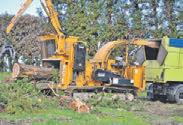

• On site chipping for stand off pads
• Wood chip for sale

• Orchard shelter removal
• Stump removal
• Woodlot marketing of all tree species
be ready for picking mid-April. ose with the new red kiwifruit variety pick earlier and there are a few hectares of that on the road, including three hectares owned by his uncle, says George Muir. Other growers would need to start picking earlier than them, he says.
Stressful times
George told Local Democracy Reporting they could lose $4 million if the fruit was not
Have YOU protected your property to alert you when this type of thing happens?

Are your Cameras giving you the results you would really like to have?


picked in time. He estimates there is around 200 hectares of kiwifruit across the a ected properties that could result in a loss of $15 to $30 million, depending on people’s yields.

“It’s pretty stressful because we’ve outlaid several million growing the crops.” says George. His brother Ben Muir says they have spent around $2m growing the fruit.
“We’re nearly at harvest time
now, so we’ve invested all that money into growing crops and then if it can’t get harvested, we’re in big trouble.”
Potential issues


Ben estimates around $20 million has been spent on crop establishment across the orchards on the road.
“ at could be crippling for some [people]. If someone’s got high debt loading, that would probably be enough to tip them over.” ...continued
Well now with the latest technology - Crystal Clear Cameras are available to everyone. See the face of that person of interest clearly, read the number plate of that vehicle or see what they put in their pocket like never before.


Call us today, and we will see if we can help you! Let




Page 4 COAST & COUNTRY NEWS
George and Ben Muir could lose $4 million if their fruit is unable to be harvested. Photos: John Borren.
STOP
one
for all your Technology and Security Needs: • Security Alarms
24/7 Monitoring • Access Control • Gate Alerts • CCTV Surveillance Systems • Data & Fibre Networks
Local & Long Range Wi-Fi & Data Plus many other types of Electronic Surveillance products! Make the right choice now, CALL the No.1 Company for Technology 0800 936363
Your
stop Shop
•
•
us
NOW! Demo Vehicle available in Auckland / Waikato & BOP Areas Nationwide Service - (well almost!) www.smartway.co.nz 07 824 5566 info@smartway.co.nz one shop For: Shopping Malls, Commercial, Residential, Farms / Rural Properties, Schools & Other Government Buildings Install a Gate Alert System yourself so you know when someone enters your property. Available as 1 to 4 Gate Systems. (2 or 4 Channel Base Stations) Prices start at $650.00 + GST for a single gate. Call Now for a Price IMPORTANT CHOICE ST Voted
show you the future because it’s here
be harvested in time

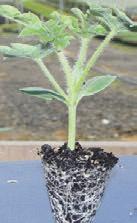
bridge installation is four weeks.
“Installation of a Bailey bridge is ever-changing and dependant on the site conditions, and our timeframe of completion could always move out.”
Jim says the original February 9 estimate for the bridge opening was based on using the existing road which started subsiding after this date was communicated to the residents.
Bailey bridge
e bridge on No 4 Road washed away after heavy rain on January 29. continued...
Another potential issue is whether truck and trailer units will be able to get to the orchards. e turning circle at the end of the Bailey bridge may not be wide enough for truck and trailer units.

Ben says they also have forestry, beef and sheep farming that will need to be trucked out soon.
“ ere’s quite a few impacted parts of our business if you can’t have truck and trailer units.”
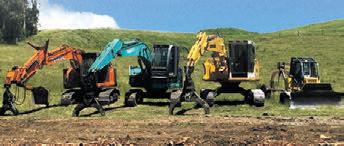

Residents have access via a private road and bridge that connects with Manoeka Road but it is not suitable for heavy vehicles.
e Muir’s also have concerns about emergency services being able to get to residents.
Ben spoke to a volunteer re ghter who suggested if there was a re on the road people needed to be able to put it out themselves, as a truck couldn’t use the private accessway.
Timeline


“If we needed emergency help, they say you can get a helicopter, well you can only get a helicopter if the helicopter’s available and you can only get a helicopter if you’re in fair weather.” e pair along with other residents want a timeline of when the Bailey bridge will be installed.
Western Bay of Plenty District Council transportation manager Jim Paterson says the approximate timeframe for the Bailey
Geotech and engineering assessments located tension cracks on the southern embankment which raised concerns about the ground’s capacity to support the Bailey bridge, he says. Longer and larger piles are needed to support the bridge and foundation, says Jim.
e Bailey bridge will remain in place for more than six months but this could “very likely” be extended, he says.

In regards to emergency services access, Jim says council have been in direct contact with emergency services to provide them with the latest information for their contingency plans.
“ ere have been no concerns from emergency services regarding access.”
Western Bay Mayor James Denyer says No 4 Road is the council’s highest priority in terms of getting infrastructure xed.
A permanent bridge will take a year to 18 months to build, says James.
-Public Interest Journalism funded through NZ On Air.




Alisha Evans, Local Democracy Reporter
Supporting farmers following Cyclone Gabrielle


Cyclone Gabrielle is having a devastating impact on farmers, their families and some communities that are already under signi cant stress and pressure, says Beef + Lamb NZ chief executive Sam McIvor.
“Our hearts and thoughts go out to everyone a ected by Cyclone Gabrielle and B+LNZ is ready to provide whatever help we can to farmers.
“We’re working with our partner organisations DairyNZ & Federated Farmers, along with the Rural Support Trust and the Ministry for Primary Industries, as part of the Civil Defenceled response. “Along with our partners, we’re emphasising to the Government that communications, electricity, people welfare and safety are urgent priorities.
“Access and damage to infrastructure is already restricting farmers and communities in assessing the cyclone’s full impact. is must also be a priority.”
Signi cant practical and nancial support will be required in the coming days, weeks, and months for rural communities and while the Government’s announcement of a $4 million mobilisation fund is welcomed, farmers and communities must be able to access it easily, Sam says.
“We’ll be working with other agencies to ensure there is a well-coordinated process for farmers to receive this support and to ensure that farmers’ needs are well understood and communicated to government agencies.
“Our thoughts are with the many farmers and rural communities that continue to be a ected.”

Page 5 COAST & COUNTRY NEWS
TOP FEATURES P: Nathan: 022 573 8030 | Andrew: 022 573 4910 E: sales@boptractors.co.nz | www.boptractors.co.nz
Rough start for kiwifruit harvest



New Zealand’s 2023 kiwifruit harvest has had a rough start.
e rst crop was picked in Pukehina, outside Tauranga, on February 16, and more kiwifruit is expected to be picked around New Zealand over the coming months. is was grower Robert MacKenzie’s rst harvest of red kiwifruit for his 0.84ha orchard under management by Levi Hartley from Prospa.
Zespri’s new RubyRed variety is picked rst which is then followed by




























the Gold and Green varieties. e harvest traditionally peaks in mid-April and runs through until June. 2023 marks the second year that RubyRed will be sold as a commercial variety.






2023 volumes


































Adverse weather volume over recent months has meant that the 2023 season is forecast to be a lower volume year than last year’s 160 million trays exported to overseas markets. On average, each tray has around 30 pieces of kiwifruit.
Cyclone Gabrielle managed to spread its wind and rain across every kiwifruit growing region in New Zealand at a particularly critical time for kiwifruit growth so close to harvest. “Although the situation continues to evolve, our primary concern at this time is with the immediate needs and wellbeing of the impacted members of our industry,” says NZKGI CEO Colin Bond.
“I have been working closely with other leaders from the horticulture industry, Government and stakeholders within our industry to ascertain the extent of the damage and the immediate needs of our people. No doubt that there will be medium and long term needs for some those impacted too.
Grower impact
“I also recognise that the ooding prior to Cyclone Gabrielle as well as the halting of the February progress payments had a larger impact for some growers.

“Our focus is on alleviating a range of pressures on many growers at this time. In addition, there is also a wider concern with the recent climatic conditions, including lack of sunlight hours, which may impact on fruit growth as harvest approaches.”
e industry has been working hard to lessen ongoing quality issues that hampered last years’ harvest.









Growers have also faced adverse weather e ects such as hail, frosts, cyclones and associated

































ooding in the lead up to harvest that have impacted on kiwifruit volumes. Combined with a year of poor opening of ower buds which form kiwifruit, this season looks to be an extraordinarily challenging one for growers.

“While this years’ poor budbreak and weather means that it is too early to have a good grasp on the seasonal labour requirements to pick and pack the 2023 harvest, the lower forecast volume for 2023 indicates that we will need less labour than 2022 which required around 24,000 people,” says Colin.
“ e reopening of New Zealand’s borders, lack of Covid-19 and downward economy indicates a temporary respite from the severe labour shortages of previous years. At this time, while the number of Working Holiday Visa Holders entering New Zealand is reassuring, it is not yet clear if the horticulture industry will receive its full allocation of RSE workers due to visa and ight disruptions.” e industry is also mindful that the drop in volume of kiwifruit produced in 2023 only provides the industry with temporary alleviation, the pressure to source su cient labour in 2024 is forecast to return when volumes signi cantly increase.




New Zealand has about 2800 kiwifruit growers located from Kerikeri to Motueka.


“ e industry must work together to ensure the 2023 season runs as smoothly as possible despite the curveballs being thrown.


“I encourage Kiwis to get involved in the industry, whether it be picking, pruning, packhouse work or otherwise.”
“It’s an industry that has roles to suit everyone, it’s rewarding, exible, and the pay rates are competitive,” says Colin.
New Zealand’s kiwifruit industry is horticulture’s largest export, with an economic contribution of $2.4 billion in 2022 which is expected to grow to over $3.8 billion by 2030.
Page 6 COAST & COUNTRY NEWS
First lot of kiwifruit being picked in Pukehina.
Maize forage trading protocol goes high tech

across every kilogram of maize forage being traded, and provided that NIR unit meets the criteria as outlined in the revised Good Practice Guide, then it is logical that this is a smart practice for determining dry matter.
“It is also important to remember that maize forage is a heterogenous plant, with the grain being almost twice the dry matter of the stover at harvest; any small error in the way hand samples are collected can quickly alter the dry matter of the sample being analysed.”
When using the updated Good Practice Guide both parties, the buyer and seller, need to agree on which whole plant dry matter determination methodology is to be used – the current sample collection process or the John Deere HarvestLabTM 3000 NIR.
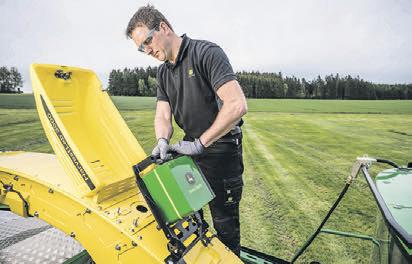
is season, for the rst time, maize growers and purchasers have the option of using a high-tech sensor as a measurement tool during harvest for maize forage trading. New Zealand is possibly the rst country in the world to provide the option, streamlining the information-gathering process.
e potential to use a near-infrared spectroscopy sensor, which is mounted on the delivery chute of a forage harvester to measure whole plant dry matter as it passes through a eld, will provide an alternative to the current practice of physically collecting samples.
NZ maize Foundation for Arable Research senior maize researcher David Densley says that around 80 per cent of the maize grown in New Zealand is for silage, with about half of that traded between maize growers and dairy farmers.

For a fair transaction to occur between grower and purchaser, determination of dry matter tonnes (tDM) requires accurate weights of each truckload harvested (wet weight) and the dry matter percentage of that forage.
“We are excited about the opportunity to use this NIR technology as a tool to determine whole plant dry matter percentage after a rigorous evaluation by our research team and other collaborators.” Most of the industry uses the Good Practice Guide for the Trading of Maize Forage which has been available since the mid-2000s. e guide, which is now overseen by FAR, provides protocols for the fair trading of maize silage between growers and dairy farmers.
For this harvest, only the John Deere HarvestLabTM 3000 NIR technology has been approved for inclusion in the updated Good Practice Guide (Version 3.0).
However, other manufacturers are also welcome to validate their technology against laboratory results, and once peer reviewed, they can be considered for inclusion in future editions, says David.
Assessment
Contracts and protocols for using the new technology are available for the 2023 harvest.
e John Deere NIR assessment was undertaken during the 2020 and 2021 harvests across a wide range of hybrid maturities and dry matters and compared the accuracy of its HarvestLabTM 3000 NIR sensor technology with laboratory results. is showed that its dry matter measurement was on average within 1 to 2 per cent of the laboratory analysis.
e sensor uses NIR spectroscopy, and works by projecting a beam directly onto the maize as it passes the lens. Parts of the light are absorbed and the rest of the light is re ected. e re ected portion is detected and with a subsequent calculation the sensor can determine the dry matter content along with ingredient values.
“Summers are becoming hotter and drier, so there is an increasing level of maize variability within the eld. is makes the practice of hand sampling to determine dry matter increasingly challenging.
“Because a NIR unit mounted on the forage harvester has the ability to measure dry matter

Recently, a major end-user in the UK specified that they would now prefer to buy products from New Zealand that were grown or raised on reduced nitrogen and phosphate land. We believe this is a start of a new trend that will be here to stay.
WE HAVE THE ANSWER TO MAINTAIN HIGH PASTURAL YIELD WITHOUT FERTILISER NITROGEN
Rolling to steep sheep and beef unit at Ballance. We first applied at Functional Fertiliser mix in 2010 and have applied to 85ha every year since.
We have enjoyed outstanding animal health with both sheep and beef animals regularly achieving top prices at the local sales yards. Independent analysis showed our soil quality to be second to none.
– GRAEME AND JUDY OLSEN
Functional Fertiliser applications over four years have transformed our rotationally grazed pastures into a highly productive summer dominant clover sward.
The “fertiliser’ soft carbon combination brought our soil and pasture to life with amazing alacrity.

Our spring pasture growth supported a stocking capacity of 40 su/ha with the pastures still requiring topping. The Functional Fertiliser wrap around support service has been exceptionally helpful.
– LINDSAY
This stuff is amazing. I have clover coming up where there was none before, thanks!

– LANCE UNSWORTH
We have a small organically registered farm near Otaki specialising in cattle finishing. In the 8 years since applying Functional Fertiliser no nitrogen has been applied and the changes have been exceptional with very strong clover growth providing all the nitrogen required.
It took a little time to kick in however our animal health has been exceptional with no lice or worms and very few vet bills resulting in a low cost easy to manage and profitable operation. The property is at least carbon neutral, and the pastures largely look after themselves.
The stock agent says we fatten cattle quicker than others with two year old carcass weights of 280 – 300kg with the meat having exceptional flavour.
Our costs are 30% less, with 30% less labour required. We run fewer animals with a 30% increase in overall profitability. It’s an easy-to-follow system that is equally successful on both large and small operations.
Functional Fertiliser really works. It sweetens the soil creating the ideal environment for mycorrhizal fungi and beneficial microbes resulting in strong growth throughout the year.
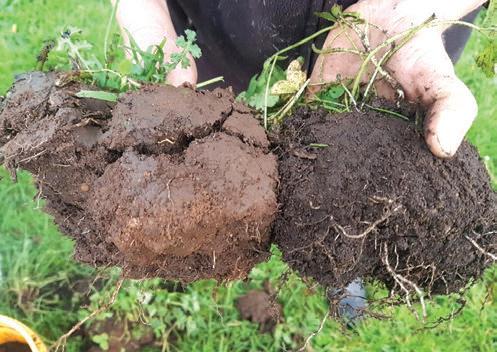
– STUART PRITCHARD


Page 7 COAST & COUNTRY NEWS
e John Deere HarvestLab 3000 being prepared for action.
e John Deere HarvestLab 3000.
THESE TESTIMONIALS CAREFULLY. Proof it works
PLEASE READ
YOUR LOCAL CONTACT Charis Work charis@functionalfertiliser.co.nz 027 257 1343 www.functionalfertiliser.co.nz
Autumn repasturing - Key principles for seed mix design





e planning of a seed mix should take into account the cost and bene ts, feed production or DM, long term goals and climatic considerations, recommends Pastoral Improvements.

When a pasture has been a ected by excess or too little moisture, selecting the right seed mix is vital.

In order to ensure livestock performance, a feed bank or feed crop should be considered.
A high performing annual ryegrass such as Afterburner combined with annual clovers can be a cost e ective option for feed production pasture or as a stitching seed mix.


For a long rotation permanent pasture, a key component is often a tetraploid hybrid ryegrass, such as Dual, which is a proven performer and cost e ective.

Pastoral improvements

When sowing, consider the additional bene ts of adding legumes and herbs, such as the renowned highly palatable Hercules Plantain.
Expert advice from a seed specialist, such as Pastoral Improvements Ltd, should be sought for best results.
Including their own innovation and export based production, they have forged relationships with international seed companies who share knowledge and improved plant genetics, which can enhance farm production systems.
Improved forage crops



A relationship with a seed company, like Pastoral Improvements, who understands the advancements in plant breeding can result in improved forage crops with increased production in an environmentally sustainable way.
Afterburner Annual Ryegrass is a fast establishing winter active ryegrass with extended longevity.





Ensure fertility and nutrient issues are known and work in conjunction with your nutrient advisor to achieve maximum production.

By considering these key principles you can optimise performance and cost e ectiveness in feed production and pasture management.
Wet weather feeding strategies


Prolonged wet weather can saturate soils, a ecting the ability of farmers to farm as they would normally.
Pasture walk/drive to establish feed situation and boost feed supply – well-fed cows cause less damage, says DairyNZ.

Hold your pasture rotation length, speeding up the round (o ering cows a larger area) can result in less pasture being available next round.
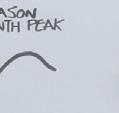
If you increase the area o ered, be prepared to feed more supplements next round.

Use extra supplement to hold or extend round. Update feed budget and monitor amount of supplement on hand.
Feed out before cows go onto the break or into the paddock (less walking around the break). Take care when changing cows’ diets, and slowly introduce them to di ering feed types and quantities. Take special care with grain and avoid feeding too much too quickly.
Increase at no more than 1kg per day and only after the cows have been eating 1kg grain for at least ve days.
Page 8 PASTURE RENOVATION
SEEDS QUALITY PASTURE SEED CRI DGE GRAIN & SEED DRESSING www.pastoralimprovements.co.nz USE OUR KNOWLEDGE to your advantage! We offer a large range of RELIABLE HIGH QUALITYPROVEN PASTURE SEED at a fair price. 0800 NZSEED Talk to the experts or email us enquiry@pastoralimprovements.co.nz Call us on 0800 183 358 or visit your local seed merchant. AGC2320 Maximise your growth window with Reason –the new mid flowering perennial ryegrass. •Well balanced seasonal growth with excellent early spring growth •Very good tiller density •Extremely low aftermath heading in summer •Excellent tolerance to a wide range of environments AGRICOM.CO.NZ/PRODUCTS/RYEGRASS/PERENNIAL/REASON GET YOUR SEASON OFF TO A GREAT START.
Planting rates and maize yields
Maize crop plant populations will continue to increase as part of the ongoing drive to lift maize yields, says visiting United States maize expert Professor Fred Below.

Professor Below, who was keynote speaker at the Foundation for Arable Research’s Premier Maize Event in Hamilton last month, says this will trigger other management changes including a shift to narrower row spacings.
While average maize yields in the US go up and down depending on the weather, overall these lift about one tonne every seven to eight years because of improved genetics and better management.
Associated with this is a linear increase in the number of plants. In the US, plant populations go up about 900 plants per hectare per year and are currently almost 79,000 plants/ha.
“ is will continue to increase, despite the high seed cost.”
Components
Yield is based on three key components, the number of plants per hectare, kernels in each plant and the weight of each kernel.
“To increase maize yield, you have to increase at least one of these. Which one do you have the most control over? It’s plants per hectare,” says Professor Below, of the Crop Physiology Laboratory, University of Illinois.
Professor Below calculates that the maximum plant population in the US at a 76cm row spacing is 93,000 plants/ha.
“Over that, you are at risk of competition, shading and lodging.”
FAR senior maize researcher David Densley says New Zealand conditions mean that the upper limit for plant populations will be higher than in the US before the need to switch to narrower rows.
“Our cooler nights and even cooler days and fewer extreme temperatures allows more plants to be grown, but there will still be a tipping point.”
Professor Below’s research team have made a major investment in trial work to compare 76cm and 51cm rows.
“One huge advantage of narrow rows is that they can intercept more light and manage a higher population of plants.”
A planting rate of 109,000 plants/ha in a 76cm row resulted in a plant-to-plant spacing of 12.2cm, which is too close for grain production, but may be manageable for silage. “You don’t want to sit too close to someone at the dinner table, you want some elbow room. Maize plants are the same.”
Increased populations

In contrast, in 51cm rows, the plant-to-plant spacing is 18cm. “Going from 76cm to 51cm row spacings is worth anything from an extra half a tonne to 1.5 tonnes for grain.”
However, as the plant population is increased, the size of each plant’s root system gets smaller. For every 1000 more plants per hectare there is a 1 per cent decrease in the root mass per plant. is is reversed when the row spacing is narrowed.
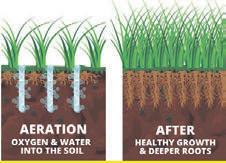

To ensure adequate plant nutrition for high yield as






plant populations increase, Professor Below advocates better source, rate, time and placement of fertiliser. Better placement of fertilisers is important as the horizontal spread of a maize plant’s root system is only 15cm to 20cm. “Maize roots do not cross the row.”
He believed future practice would be the banding of fertiliser placed 10cm to 15cm deep, directly below the future crop row. In strip till this can be put in the strip.
“ e rst time we did that, in 2009, I couldn’t believe it. is was the biggest e ect on yield I had seen in my career. I know this is hard and it is slow but this has to be the future of maize production.”
Growers also need to do a better job of placing side dress fertiliser applications. In the US, a technique called Y drop is used which places fertiliser, usually

in liquid form, on the surface along the plant row.
Another innovation in the US is short stature maize, with a height of 2.1 metres compared with conventional hybrids at 2.7m to 3.6m.
Maize is the last major grain plant to be dwarfed. Short stature maize has a number of environmental, management and physiological advantages compared to conventional tall maize hybrids, Professor Below says.
Plants have a thicker lower stem and are better able to withstand wind. ey are
also di erent in how they partition energy, with short stature maize putting 26 per cent of its energy into its stalk, compared with 36 per cent for tall maize. is allows more energy to go the plant’s leaves, ear and root.

e lower height also makes it a lot easier to ground spray and apply side dressings, even at more mature stages.
“Maybe it is not so good for maize silage, but be ready for the advantages of short stature maize when growing it for grain in wind,” Professor Below says.
•Available with AR37 and AR1 endophyte

•Outstanding summer, autumn and winter growth


• Excellent density for periods of set stocking and winter grazing

•Very low aftermath seeding and excellent summer leafiness
•Very good tiller size and leaf length
AGRICOM.CO.NZ/PRODUCTS/RYEGRASS/PERENNIAL/LEGION
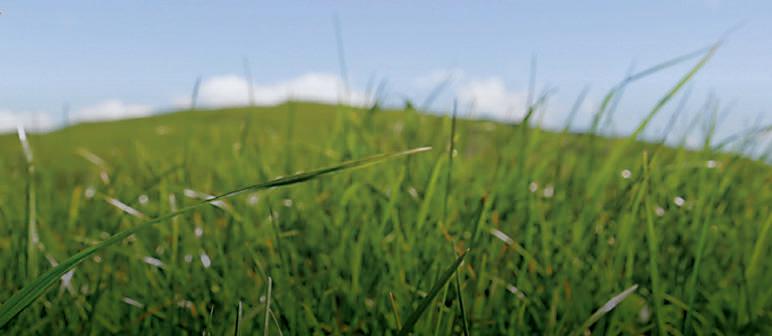

Page 9 PASTURE RENOVATION
Visiting United States maize expert Professor Fred Below of the University of Illinois (far right), with FAR senior maize researcher David Densley and communications manager Anna Heslop.
HUGE RANGE AVAILABLE! 2M, 2.5M, 3M, 3.5M, WIDE 4-6M ON ENQUIRY MAXIMISE SOIL YIELDS IMPROVE SOIL QUALITY DEEPER ROOT STRUCTURE FAST OPERATION L OW SURFACE DISRUPTION ADJUSTABLE PENETRATION ROBUST & RELIABLE GREAT TOP SOIL SHATTER 0800 465 963 www.kyneequipment.co.nz @BarenbrugNZ facebook.com/BarenbrugNZ barenbrug.co.nz The ultimate mixer. Redefine cocksfoot Call us on 0800 183 358 or visit your local seed merchant. AGC22321 Grow your future on a fertile foundation with Legion perennial ryegrass – the complete all rounder.
THE ALL REGION, ALL SEASON, COMPLETE ALL ROUNDER
Sunrise opportunity for farmers!


e time is right for FARMERS to reclaim organics from the green environmental left and take a hard look at what it is really about.
e kiwifruit, process and fresh vegetable, apple and grape wine industries have been very successful and active in export markets, often citing the fact that having an organic portfolio has made conventional sales!
For the rst time since the 80’s the dairy industry is taking organics seriously!

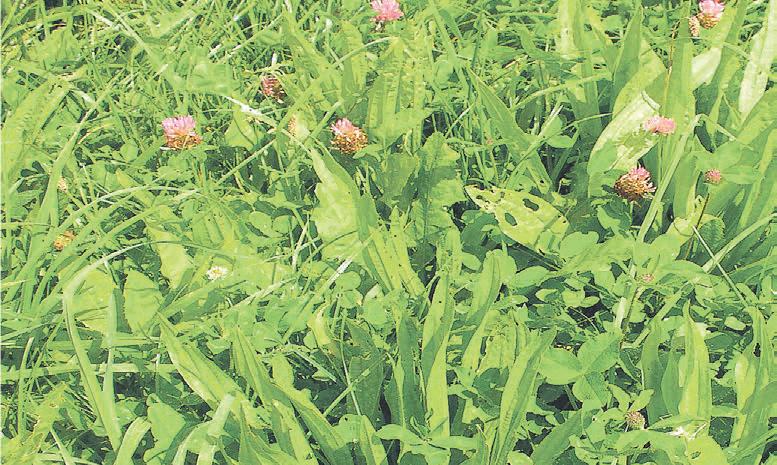
Fonterra are processing product at Waitoa (pictured right), Hautapu and Morrinsville, they are also supportive of the Dexcel, Massey and Organic Dairy Producers Group joint e ort to establish an advisory service, ‘ e Organic Dairy Extension Service”.
e industries that are using organics are seeing massive transfer of ‘best organic practice’ in to conventional properties. ere is not a single organic input supplier whose business is not growing by selling to conventional farms.

Farmers using these products need to take a serious look at their reasons for not being more open and positive to organics, is because it does not work (yet they keep buying) or some political grouping they don’t like have used organics as a focus point for other purposes.
Farmers like Tom Lambie (700 cows), TaitJamieson (280 cows), Gillats, Shelly Beach, Veronia and the list goes on – have been organic for 15 to 20 years, new ones like Marphona (1200 cows), Ridings (pictured above), Fisher and the other 20-odd certi ed properties are farming for pro t (efs) not just kgs.
Organics came out of requests by farmers (1920s) for solutions to the very problems

facing today’s Dairy industry –animal/crop health and animal/soil fertility, and again we see farmers

turning to organic systems to solve these issues. Stand up and see the herbage!
Bill Quinn


Page 10 ORGANICS IN FOCUS
Has the sun shone on organics?
Hell yes! When I wrote the lead in the 2003 edition of Organics in Focus, the dairy sector had only just begun its journey.
Whether it is kiwifruit, avocado, apple, cherry, wine or any of the pastoral productions, including eggs, organic primary production has and is growing, and in more way than just direct production.
e organic dairy sector has grown from the few farms 20 years ago to around 150 farms today, with many in the 500 to 1000 cow bracket from Northland to Southland.
Whether it is Fonterra, Open Country, Green Valley Dairy, Waiū or a number of the other marketers such as Organic Dairy Hub, Zany Zeus, Lewis Road Creamery, BioFarm, organic dairy is in the supermarket and export shipments continue to fall short of demand…we need more organic primary production in dairy and across all sectors.
Growth
Along with the growth has come the normal development issues of chicken and egg, but the sector has thrived.
Take a look through the pages of Coast & Country News, many organic advertisers/ input products are not just selling to organic producers.
e progression of the sunrise industry from 20 years ago now sees many farmers using certi ed organic inputs and practises, be it for soil, animal or crop, why? Because it works!
Last century
Let’s look back to last century for a minute, while the horticulture sector was heading down the lower/kinder input path by way of the:
- Kiwigreen program: a move from calendar spraying/management to a needs based program.







www.martech.co.nz/images/02kiwi.pdf
- Apple: the introduction of the Integrated Fruit Production program, IPM and more. journal.nzpps.org/index.php/ pnzppc/article/view/11639/11489
- e fresh vegetable sector had IPM, Save the Clod and other programs to enhance environmental impact and production margins.

www.regional.org.au/au/esa/ws/ contributed/10/walker.htm
- NZ GAP (Good Agricultural Practise), implement across broad aspects of horticulture prior to arriving in pastoral production systems.

e dairy sector was headlong down the urea and PKE tracks - well most were - driven by great sales and production growth fever, farmers were driven from outside the farm gate. ere were those that chose the organic path and most of those in organic dairy in the early 2000s are still banking the margins and enjoying the bene ts of a biological system and lower pressure farm system.
So where does Regen-Ag t?

at is the general adoption of many of the organic practises used in all organic primary production, which is where we have always valued the role of carbon

above all other elements.
e rule of return as put by Albert Howard almost 100 years ago, or by Steiner in the 1920s.
e herbal ley pasture, the use of biocontrols, feeding the soil not the plant, treating the cause and not the symptom, the list goes on. But of course as the NZ government ‘Fit for a Better World’ report (which can be found on the Ministry of Primary Industries website) states Regen-Ag farmers use Glyphosate and many other similar inputs that organics does not… and more so organic has demonstrated productivity and pro t for decades without resorting to what is often considered essential inputs, antibiotics, cyders, quick N. e promotion of Regen-Ag is a good catch-up for the pastoral sector and will over the next few years become the minimum practise. But the world market wants more, they want genuine organic. More on this topic next month.
Industrial Hemp



e iHemp industry is active and growing, with area planted still in the up and down as happens with a new and developing sector. iHemp is the crop grown for food and bre. It does require a licence to grow and if considering the opportunity iHemp provides, start work now for spring sowing. iHemp can t into the farm diversi cation plan, a couple of paddocks of iHemp followed by a winter crop or re-grassing.
e crop is best grown under organic management, as it’s an accumulator/soil cleansing crop and the market is hungry for certi ed organic iHemp products.


Watch out in the April issue for an article of commercial organic iHemp production.

Organic
manufacturing
beef ere are various opportunities in the organic red meat market. e best by far, in my opinion, is the Costco organic manufacturing beef market.
e organic dairy sector is focused on milk, and who can blame them with a rolling average m/s pay-out $2 above conventional! e opportunity is in the culls and the o spring - these are certi ed stock and many go direct to the conventional market due to a lack of ‘supply chain’ farms.
Growing need
We need calf rearing, store and nishing farms. e beauty of manufacturing is stock can be managed to the feed and if not prime, it is of no material concern. A dry summer, just move animals on to nd the balance.
e ideal setup is to have a nurse cow operation receiving calves from certi ed farms, rearing these to weaning and then selling on to store or nishing farms.
e premium for the slaughter animal is around 20 per cent above schedule.
If you farm has had no chemical applications, urea or super/DAP in the last three years you may well be able to be USA organic market in a matter of months.

e stock is available, and the market is hungry - are you the missing link?

Page 11 ORGANICS IN FOCUS
Bill Quinn
Industrial hemp (iHemp) food, fibre, carbon positive, soil building, and so much more.
GROWING THE FUTURE - iHEMP
Documenting the transition from
Morris McFall is best known as the founder of the McFall Fuel group of companies, but he comes from a dairy farming background, and was a 1970 recipient of a Nuffield Agricultural Scholarship in intensive dairying industry. He has always had an interest in all things mechanical and agricultural machinery. When he passed the family business onto his

youngest son in 2016, Morris turned his attention to adding to his interesting machinery collection.
e extensive collection is housed in a museum at Mount Maunganui that Morris’s middle son















Bryce is involved with.
“Most collectors have a passion for a particular brand but I wanted to collect tractors and machines that represented the era where we transitioned from draught horses to fuelled machinery,” says Morris.


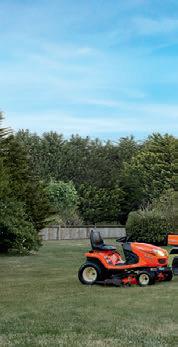


His carefully curated collection has most brands







on display, each one fully restored by Morris himself if required. He has three John Deere tractors that he feels represent a clear lineage before the new generation models were introduced.

More than one

e rst is a John Deere AW, a two cylinder petrol engine, row-crop tractor with 28 HP. Around







and has a wide adjustable front axle. “I picked this one up in Invercargill around 2010 and I nished the partial restoration that had been started.”
e second is a 1952 John Deere R, a two cylinder diesel engine
Page 12 FARM VEHICLES & MACHINERY
continued...
Morris McFall has three John Deere tractors representing the brands progression to new generation machines.
KUBOTA.CO.NZ 07 573 9107 4 Te Puke Quarry Road, Te Puke www.rrtractors.co.nz BX2380 $22,500 * +GST Fitted with LA344 Loader and RCK60 Mid-mount mower 23HP Kubota diesel engine Switching between mowing lawns & front end loader work has never been easier. The BX loader can be attached without leaving the driver’s seat Deluxe reclining high back seat, spacious operator area, cruise control and easy to reach controls *Image without mower deck. Price includes mower deck. ZD1221 30 HP Kubota 3-Cylinder Diesel Engine Cutting Height 25-127 mm, rear delivery Shaft Drive Deck & Hydraulic Deck Lift COMPETITIVE FINANCE AVAILABLE across the BX & Z Series KUBOTA’S LIFESTYLE RANGE *Terms and conditions apply. Finance subject to DLL’s normal lending criteria. 0% interest rate, 30% deposit, with monthly payments over 24 months and GST back month 3. Finance deal applies to all tracked excavators (base machine only). Offer ends 31st March 2023 or while stocks last. FROM 1.8 TO 27 TONNE Always looking for a better way CONSTRUCTION It’s never been easier to get into a JCB. Give the team at Power Farming Bay of Plenty a call on 07 543 0021 to lock in this fantastic 0% finance offer. Stock is on hand and ready to go, so secure yours today. Power Farming Bay of Plenty Owen Jessop Sales Manager 027 337 6963 Dave Horgan Sales: Te Puna, Katikati, Waihi 027 555 2308 Cameron MacNiven Tauranga, Kaimai, Pyes Pa, Welcome Bay 027 217 3652 Hayden Riddell Sales: Te Puke, Paengaroa, Pongakawa, Pukehina, Matata 027 336 2193
became
Photos: Catherine Fry
Morris McFall collects machinery and tractors from the era
where draught horses
a thing of the past.
horses to machines in agriculture




imported from Australia and Morris bought it in Welsford in 2021, fully restored and in mint condition.
“I feel my collection documents the era well. Most of the machines re ect the 1940s and 1950s, but I have some dating back to the 1920s.”
...continued

“It uses a small two cylinder petrol engine to warm the machine so that the diesel engine will re up. It was John Deere’s rst diesel tractor.

Origins
“My R was originally from Australia, but I found it in the Christchurch area in 2012. It had a restored engine and I did all the cosmetic work.”
e third is a 1959 John Deere
830. is two cylinder diesel engine has 77 HP, and by then diesel had developed and it started from cold.












Limited


“Very few of these came to New Zealand and it was a general utility tractor which was high performing and expensive. It would have been one of the last two cylinder tractors John Deere ever made.”







e 830 had previously been

Tractor racers raise funds for charity

Engines were revving and mud was ying as spectators sat on the banks of Fieldays 2022 watching competitors race against the clock, all in the name of the Rural Support Trust.
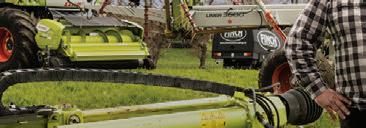

New Zealand National Fieldays Society Chief Executive Peter Nation is thrilled to have raised $4500 towards the Trust’s critical work.

“Mental health is a big area of concern in rural communities and people often don’t know where or who to turn when things get tough. e work that the Rural Support Trust does is vital.
“Also given what rural communities have had to endure this past week with the weather, makes what the work Neil and his team do so important.”
e money was raised through a rst ever Tractor Racing Experience at Fieldays.




Ag Drive quickly stepped in and modi ed the much-loved annual tractor pull competition, o ering visitors the opportunity to get behind the wheels of one of two identical tractors.
As a result, Fieldays visitors were able to sit alongside Ag Drive instructors, the hardcore competitors times were tallied, with the fastest participant’s time being crowned the day’s winner!
“It’s not hard to have fun when you’re behind the wheel of a 200hpCase IH tractor racing your mates,” says Peter.
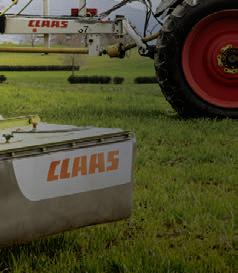
“ e Ag Drive team were amazing; they gave their time and expertise and it was a real thrill for people to get this opportunity.”
Rural Support Trust is a not-for-pro t network of regional trusts that provide free and con dential assistance to rural people facing challenges in everyday rural life.

e Rural Support Trust is made up of









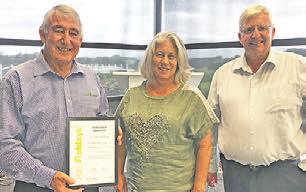
farmers and those with a good understanding of rural life, acknowledging that the farming community face many stressors around health and wellbeing, nancial pressures, animal welfare, employment and weather..







Page 13 FARM VEHICLES & MACHINERY
John Deere AW.
1959 John Deere 830.
1952 John Deere R.
Catherine Fry
Some of the tractors in the McFall Museum collection.
LAN2521 “ CLAAS gear
service
DARCY FINCH Finch Contracting f Top chop quality with MAX CUT cutterbar f Active float - perfect ground contouring f Perfect cut - clean forage and perfect crop flow f SAFETY LINK - advanced safety system f MAX SPREAD crop flow f Permalink drive concept f From 5.2 - 13 m working widths f Single and twin rotor options f Grass Care concept fully floating rotors f 3-dimensional rotor travel f Hermetically sealed low maintenance CAM track CLAAS DISCO MOWER CLAAS VOLTO TEDDER CLAAS LINER RAKE *Standard CLAAS Financial Services lending criteria, terms, conditions and fees apply. 0.99% p.a requires minimum 33% deposit followed by two six monthly repayments over 12 months. Offer valid until 31/03/2023 or while stocks last. Offer applies to in stock and on-order new Category 2 Greenline equipment. Excludes Triple Mowers, quad-rotor rakes and CLAAS Balers. If finance base rates move by more than 0.25%, CLAAS Financial Service reserve the right to re-quote. ABN holders only. Images illustrative only. reliable THE PROFESSIONAL’S CHOICE FLEXIBLE TERMS AVAILABLE OWN THE GEAR THE PRO'S USE LOCK IN 2023 this offer now for spring delivery FROM claasharvestcentre.com BAY OF PLENTY 80 Wahanga-A-Rangi Cresent, Rotorua Craig Macdonald 027 223 3365 Glenn Davidson 027 223 3363
Neil Bateup (RST), left, Janine Peters (Ag Drive) and Peter Peter Nation (NZNFS).
is reliable and the
team
is always there when
we
need them. ”
Calls for care and courtesy on NZ roads
Harvest season is in full swing and Federated Farmers is urging motorists and the operators of agricultural machinery to show each other some care and understanding.



New Zealand’s $2.2 billion arable industry is an important part of our export earnings, economy and employment - not to mention growers of wheat our for your summer sourdough.
During harvest, combine harvesters, large tractors towing implements and other over-size agricultural vehicles often need to use public roads to move between di erent parts of the farm and between farms.

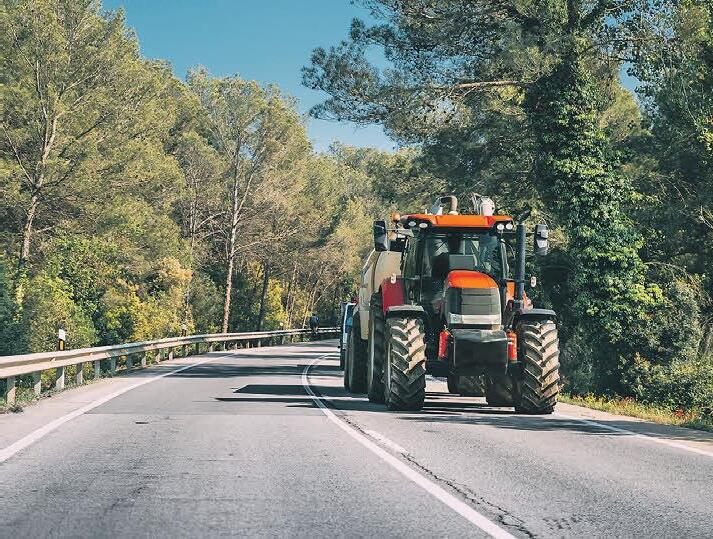
Bulky necessity

“ ey’re bulky and of necessity - and by lawmove at lower speeds than other motorists.






“Farmers are asking other drivers to show a bit of patience and common sense when coming across these large vehicles on the road,” says Feds Arable Industry chairperson and Waimate farmer Colin Hurst.

Colin Amrein CONTRACTING







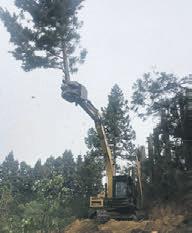
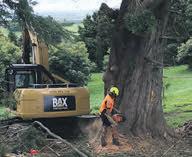

















































could be on the roads for a number of di erent reasons.
“If a tractor or harvester does pull over to the edge of the road, take your opportunity to pass if you can do so safely. Most of them will be moving no faster than 30-40kph or so, so it’s not essential to have the same several hundred metres of clear road ahead needed when overtaking much faster moving vehicles.”

Tra c ows



























Refusing to pass can result in a long line-up of vehicles and that’s when some drivers’ patience frays and they do something risky, says Colin. Federated Farmers is also urging the operators of farm vehicles to keep tra c ows in mind, and to remember their responsibilities in terms of protruding implements/headers and, where required, use of beacons and hazard panels.

Page 14 CARTAGE & EARTHWORKS
Farm vehicles of all kinds
Ltd
Pete & Marcus
Petition calls for safer highway access





Shaw Road residents near Whakatāne say Waka Kōtahi’s safety improvements to State Highway 30 will do nothing to alleviate what they consider to be “a very dangerous intersection”.
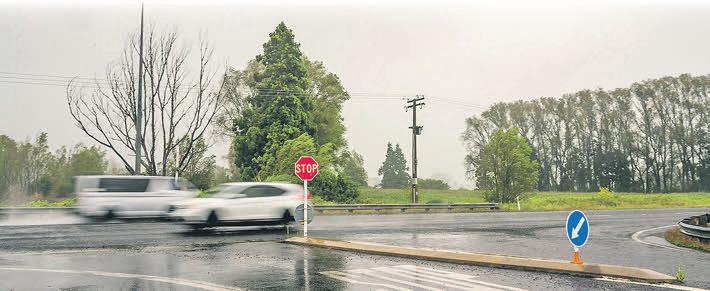
Noel Christensen has put together a submission to transport agency Waka Kōtahi signed by 90 pe rcent of those residents.



Noel says his biggest concern is with the left turn out of Shaw Road onto a 100kmh state highway.
He says no other high-density residential subdivision between Whakatāne and Tikitere or between Whakatāne and Tauranga exits and enters from a 100kmh state highway.


“A median barrier would make no di erence to how dangerous this intersection is.”
Calculations





Noel, who has a good view of the intersection from his home, has counted vehicles headed toward Whakatāne on SH30 go past the intersection and says it varies from 22 vehicles a minute at quiet times to more than 40 a minute at peak times. He has calculated that this amounts to a window of between 1.2 and 3 seconds for a car pulling out of Shaw Road to achieve 0kmh to 100kmh between the passing cars.
He says everyone he has talked to has witnessed drivers taking risks when pulling out, due to frustration.
Waka Kōtahi’s plans to lower the speed limit to 80km/h will do little to help, he says.
“It needs to be at least 60kmh.”





Ideally, Noel would like to see a roundabout at the intersection, or failing that, a merging lane. He has provided several suggestions about how
this could be achieved.
Waka Kotahi NZ Transport Agency’s proposed safety improvement plans for the highway between Whakatāne and Awakeri includes median barriers and no-right-turn intersections on 10 side roads, including Shaw Road, along with roundabouts on the intersections of ornton, Te Rahu and White Pine Bush roads.


e changes will mean all tra c wanting to turn west out of Shaw Road will rst need to drive 1.5 kilometres eastward to the nearest roundabout to turn around.
Tra c wanting to turn into Shaw Road from the east will rst have to travel just over one kilometre past their homes and return via the new ornton Road roundabout. is inconvenience is another concern voiced in Noel’s submission.
Public information


Waka Kotahi infrastructure delivery regional manager Jo Wilton says the current proposal for the design doesn’t include a roundabout or merge lane for Shaw Road, but it will soon be looking for input from the public to help inform the nal design.
“As part of the feedback on the design process, Waka Kotahi would like to hear from people about how they use and experience that intersection, as that provides important information for the team to consider.
“All information gathered through this process will help inform our nal designs.” Public information sessions will be held in late March 2023. ey will advertise these widely before they are held. People can sign also up for updates at: www.nzta.govt.nz/sh30awakeri2whk

Page 15 CARTAGE & EARTHWORKS
e Shaw Road intersection is the only one Noel Christensen is aware of that has a residential development exiting and entering via an intersection o a 100kmh speed limit highway. Photos: Troy Baker.
Noel Christensen has gathered more than 120 signatures, which amounts of 90 per cent of people living in the Shaw Road development, for his submission to Waka Kōtahi New Zealand Transport Agency.
ADDLINE TRANSPORT LTD
Diane McCarthy, Local democracy reporter



























Page 16 RURAL HOMES & BUILDINGS dMaste B d rs House o th e Y ra GOLD AWARD 2015 Are you looking to build in Waikato, Bay of Plenty, Eastern Bay of Plenty, Rotorua or Taupō? Check out our two stunning Showhomes located in the Waikato and Bay of Plenty regions, where we showcase what our multi-award winning building teams can do. Head to our website to find out more, or contact us today. DON’T BUILD A HOUSE, BUILD A LANDMARK. LANDMARKHOMES.CO.NZ CONTACT US TODAY 0800 477 110 Escape the ordinary with Landmark Homes.
“Elusive unicorn” leads to new build
a problem. Some of those changes included opening the lounge, dining and family rooms into one big open-plan space to create fantastic ow through the home and turning the bathroom o the kitchen into a study nook. We also changed the sloping ceiling upstairs to give extra headroom.”
Several years on from settling into their new home, Sarah and Simon Cowan say they “couldn’t be happier”.
“Landmark went above and beyond to deliver the home of our dreams. “Every aspect of the build – from communication through to nish –was beyond our expectations.”
After 12 months of fruitless searching for ‘the perfect home for our family dynamics’ Cambridge’s Simon and Sarah Cowan decided to build, admitting it was a decision they never thought they would make.
“We always thought we would nd our ‘unicorn’ home so while we saw a lot of houses with
When Liz and Dick Johnson purchased a dairy farm at Tirau they knew the farm worker accommodation was not up to modern standards.

So they started investigating a new build and Keith Hay Homes stood out.
elements we loved, we didn’t nd anything which had it all,” says Sarah.
So rather than wait another year or more, the Cowans undertook a lot of research into building companies resulting in an approach to Landmark Homes.

“We ‘chose’ Landmark because of the quality of their build, the uniqueness of their plans and


their willingness to adapt existing plans to what we wanted.”
Sarah and Simon chose to use a ‘Ready to Build Plan’ because “it o ered price certainty” and Landmark’s Tekapo plan caught their eye for its size and aesthetic.
“Landmark Homes gave us freedom to alter the Ready to Build plan and nothing was ever



“Keith Hay Homes has a good reputation and has been around for a long time,” says Liz. “ ey are price competitive, have good procedures in place, the quality of the workmanship is consistent and they can deliver a nished home ready to live in.” e rst house the Johnsons purchased was a prebuilt home and was delivered at the end of May 2019, just 12 weeks after signing their contract. Just in time for the new season to start in June. ey then went on to purchase a second Keith Hay Home in 2021 as they were so happy.
Liz loves the fact that the homes are completed o site with everything completed including electricity and plumbing requirements, spectic tank, carpet, paint, heat pumps etc.

Decking is built around the homes once they have been positioned on site.

Keith Hay Homes takes care of all council work, consents and transports the home to site. “It’s a very skilled business and you know the home will be compliant and correct. ey build to very high wind zones so we are con dent in an adverse weather event the house will be tight and strong.
“ e sta just love their home and say it is the best home ever.”
For more information about Keith Hay Homes, see their advert on this page.










Page 17 RURAL HOMES & BUILDINGS
Delivering stand out builds in NZ New
Homes. LOOKING FOR A NEW HOUSE FOR YOUR FARM? Are you are looking for a new home for yourself or housing to attract the right workers to your farm? We have the right solution for you including pre-built houses ready to be delivered now. Call us today! 0800 KEITH HAY www.keithhayhomes.co.nz
An example of a Landmark Home in Whitianga.
build by Keith Hay
Lockerbie Village “Here’s to life”.
Kiwis need experienced builders in today’s market

Morrinsville
Resort-style living in Morrinsville
Stage Three almost sold out
Highmark Homes BOP was founded in 1965 by Bob Hunt and is now run by his son Ryan Hunt, making it one of the longest running building companies in the Bay of Plenty.
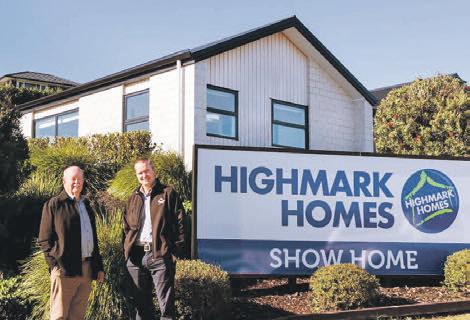


The Pavilion:
e team at Highmark Homes BOP o er a no-obligation, free site visit, providing expert advice on the best way to achieve your dream home and maximise the positioning on the land.
ey have experience in rural builds and remote areas, stormwater, and water tank installation, as well as septic tank design.




Lockerbie Village, 26 Village Boulevard, Lockerbie Village, Morrinsville 3373
“We know building a home in rural New Zealand means working with land that isn’t always at and square,” says Highmark Homes BOP managing director Ryan Hunt.
“ at’s why our standard range of 56 house plans are designed


to be exible, and can be altered to maximize your site, no matter the size, shape, or challenges.
“You can follow our plans exactly or use them as inspiration and alter them to suit your section, lifestyle, needs and budget.”
Building with Highmark Homes also enables you the exibility to choose a design

and build option. Working from your sketch, the team can produce a computer-drawn scaled plan so that you can see what your new home will look like.
Call Sally on: 027 536 1003 to arrange your free, no-obligation site visit. For more information about Highmark Homes, see their advert on this page.


Hundreds of new homes on the horizon
Almost 1600 homes are on the way in rural Waikato as the housing squeeze has buyers looking further for bargains. House-hunting in Hamilton felt “like a bit of a cattle market” for one purchaser, so he and his wife broadened their search. ey landed on a new property at Lockerbie Estate in Morrinsville – a 1500-home subdivision underway in the Matamata-Piako District that also features a 160 villa
retirement village.
Half an hour away in Matamata, Maea Fields is the 91-home foundation for what could swell to 280.
In Matamata, Maea Fields is zoned to be the foundation for 91 homes out of a possible 280 on the 230-hectare Calcutta Farms site.

And it’s part of a wider vision to expand the township further towards the east.
Mea Fields’ current listing pricing was between $700,000

to just under $1m for a house and land package.
e development is a third of the way through, after a lengthy resource consent process. Developers project the Matamata Piako District’s population will grow by more than 2800 over the next ve years, and the mayor says planning ahead is key. e two major subdivisions currently underway are expected to be near-complete in 2024. - Stuff
Wherever you are looking to build, our team of Registered Master Builders are here to help. We specialise in rural builds, providing assistance across the entire building process. We are happy to help you find the perfect piece of land, match it to a house plan you love, or offer complete customisation for your home, designing every detail to match your needs.

Page 18 RURAL HOMES & BUILDINGS
CALL TOBOOKYOUR FREESITEVISIT 050844 4462 @HIGHMARKHOMESNZ HIGHMARKHOMES.CO.NZ BUILDINGHOMESTHAT KIWISCANBEPROUDOF
Contactustodayforyourfree, no-obligationsitevisit. CallSallyon0275361003 Village “Here’s to life”. Resort-style living in Morrinsville Lockerbie Village, 26 Village Boulevard, Lockerbie Village, Morrinsville 3373
Pavilion: Multiple indoor and outdoor seating and entertaining areas with country style kitchen and fire places Heated indoor swimming pool and spa Gymnasium Library Theatre Activities room Bar lounge and pool table Outdoor terraces and BBQ area overlooking manicured gardens sold out
The
Enquire Now
Multiple indoor and outdoor seating and entertaining areas with country style kitchen and fire places Heated indoor swimming pool and spa Gymnasium Library Theatre Activities room Bar lounge and pool table Outdoor terraces and BBQ area overlooking manicured gardens
Pavilion: outdoor seating and entertaining areas kitchen and fire places swimming pool and spa table BBQ area overlooking manicured gardens
“Here’s to life”.
Bob Hunt with his son Ryan.
Inaugural delivery of Fruition Diploma

Eleven students from a range of horticultural sectors and locations around New Zealand have recently graduated from the inaugural delivery of the Fruition Diploma in Horticulture Production.

e graduation in February was o ciated by the Minister of Education Jan Tinetti.
It was the rst o cial function Jan had attended in her role overseeing tertiary education.
Achievements








Horticulture managing director Sandy Scarrow says it was a very exciting day, one in which the achievements of not only the students, but Fruition as a training provider, was celebrated.
“We have worked hard to ensure we

delivered a diploma programme that was relevant to all those engaged in the horticultural industry and that the learning would not be impacted by distance.
“We wanted our learners engaging on-line to feel as if they were in the classroom.”
Feedback from the learners has been strongly positive.
Aside from the informative content,





they have appreciated the ability to join class in Tauranga or on-line from anywhere else in the country.






Nicola Mansel talked about value in the ability to access this diploma programme from Opotiki but loved the face-to-face
Interest in wild pig non-lethal traps

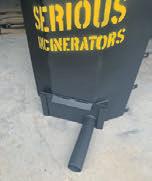


e trial of a unique non-lethal trap for wild pigs is complete and Northland’s Iron Tree Products says the trap is attracting interest from sheep farmers, hunters and environmentalists.

“Traditional pig traps are heavy and can only be moved into position with tractors, so we have designed and developed a rectangular galvanised steel and mesh trap which is collapsible and easily transported for positioning on the steepest land,” says co-owner of Iron Tree Products Milton Brown.
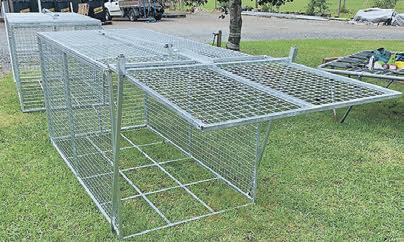
“ e pig trap is non-lethal, merely trapping but not injuring the pig, appealing to anyone for whom their land, wild life or plantings are threatened by wild pigs.
“Sheep farmers whose land borders on native

bush are often faced with stock losses during the lambing season. Our traps can easily be positioned and moved, as required, to provide a level of safety for livestock – and peace of mind for farmers.
“Equally, the traps appeal to hunters as pigs are safely caught and held, and to environmental organisations, like Councils, whose blocks of native bush su er signi cant damage from large populations of wild pigs.



“Trialling has proved the e ectiveness of the pig trap so we are now taking orders.

“Please give us a ring to discuss your requirements.”

Iron Tree Products is a familyowned business operating from a workshop in Titoki, Whangarei, and delivering nationwide. eir focus is on producing products which are well engineered and manufactured “so they last for decades”.

engagement when she did drive through to either eldtrips or class sessions.
“Horticulture is the fourth largest export from New Zealand, with a growing population and increase in demand for both an international and national markets, there is a need for more skilled managers and other technicians to help adopt innovation and increase production in our important sector.”
Options
ose keen to participate can contact Fruition Horticulture to discuss their eligibility or other professional development options available can see Fruition’s advert on this page.









Page 19
Acting Minister of Education, Jan Tinetti, Fruition Diploma graduates and Fruition Horticulture sta at the recent graduation ceremony.
Nicola Mansel receiving her diploma certi cate from Minister Tinneti and Sandy Scarrow, Managing Director of Fruition Horticulture.
Examples of the non-lethal trap.
FIRST
FREE
HOUR
City child to Dairy Industry Award



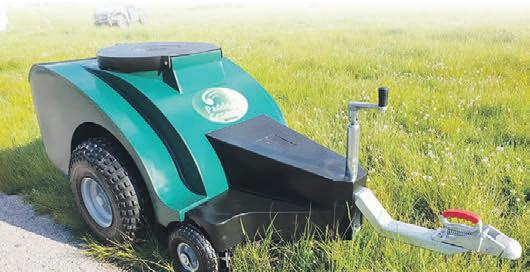

Jamie McDowell had her rst exposure to farming when her brother went to work with their uncle who was employed on a dairy farm. She used to go and live with her brother in the holidays and helped with milking and calving, gaining valuable experience.

e 22-year-old is the New Zealand Dairy Industry Awards 2022 Trainee of the Year for Auckland/Hauraki region and had a totally town upbringing and schooling in Lower Hutt, Wellington.




Interested in a farming career, Jamie completed a Level 3 Sheep and Beef certi cate at Taratahi Agricultural Training Centre in Masterton, where she lived on campus for a year.

“I went for the sheep and beef side as the variety of work appealed to me. I would be doing everything from shepherding, lambing and calving, to drenching and docking,” says Jamie. After her course, she couldn’t nd a job in sheep and beef and fell back on her dairy farming experience to get a position on a dairy farm. She progressed from farm assistant to herd manager within two years.
Valuable experience







Jamie then went to work for contract milker, Olivia Sutton, at Glen Murray in the Waikato on a dairy farm milking 326 cows at the time.
“It was Olivia who entered me for the DIA and told me after what she had done. I hadn’t even heard of them but I thought I’d give it a go!”
Jamie found the skills day and interview fun, and really enjoyed meeting new people and talking to the judges. She felt it was a valuable learning experience.
Surprise win
Much to her surprise, she won the Auckland/ Hauraki Dairy Trainee title. She also took home two merit awards - the Milk Bar Farming Knowledge Award and the DairyNZ Practical Skills Award.
“I really love the farming environment and it’s a bonus working with animals every day.” Jamie and her partner Rhys, a water pump technician, are now living on a 40 hectare run-o block which she manages for Olivia.
“We have around 60 cows there, a mixture of carry overs, heifers, empty cows and weaned calves. “We grow about 20 hectares of maize there and make grass silage cuts when it’s available.”


Jamie is a relief milker with permanent days for Olivia who now milks 380 cows.
“I also relief milk for others around the Te Kauwhata and Rangiriri area. Relief milking o ers a lot of freedom and I get to do what I love.”

Page 20
Dairy Industry Awards 2022 Auckland/Hauraki Dairy Trainee of the Year, Jamie McDowell. Photos: Catherine Fry.
Jamie loves working with animals on a daily basis.
Catherine Fry
Jamie McDowell with her two farm dogs.
Solar power super charges school camp







One of the Bay of Plenty’s most popular school camp sites will largely run ‘o -grid’ thanks to new solar panels and batteries purchased with the help of a $35,000 grant from BayTrust.
e eco-friendly initiative will also be used to teach students visiting Ngamuwahine Outdoor Education Lodge, in the lower Kaimai area, about the bene ts of solar power and the importance of sustainability. Eleven local schools including Tauranga Intermediate, Bethlehem College, Pyes Pa School, Matua Primary, Otumoetai Primary, St omas More, Oropi School, Omokoroa Point School and Kaimai School currently send around 3000 students a year to stay overnight at the lodge.
Expansion plans are well underway to cater for growing demand, with a new ‘out camp’ featuring canvas tents ready to open for 2023.
Environmental desire
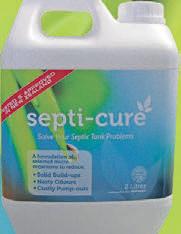

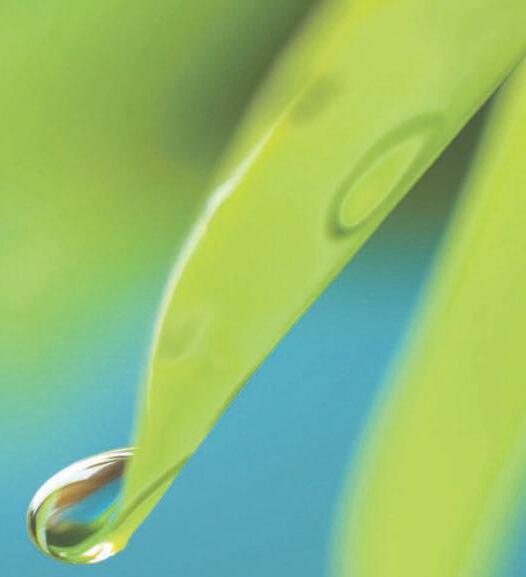




Camp administrator and head instructor Gerry Hart says the rising cost of electricity, plus a desire to make the lodge as environmentally-friendly as possible, has prompted the Ngamuwahine Lodge Trust to invest in three new solar power batteries and an additional 24 solar panels.
“Twelve years ago we did a major building development and at that time we installed 52 solar panels on the roof of our new building,” Gerry explains.
“ is has subsidised our power to some degree over the years but because we had no batteries to store the power created during the day, much was exported back to the grid.
“ e lodge uses most power in the evenings when







the sun has gone down. If we can store the power produced during the day into batteries, which will allow us to utilise it during the evening.”
e new solar power system will produce 26,557kW per year which will account for two thirds of the lodge’s annual power requirements, substantially reducing its $12,000 annual power bill.


“It will make things a lot more e cient than what we’ve got at the moment,” Gerry says. “We’ve also got hot water on diesel at present which we’re going to change over and use some of the power we’re generating with the solar system to heat the hot water.”



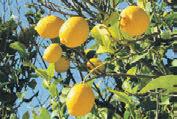
Ideal venue
e solar batteries and ability to operate during a power outage will also make the lodge an ideal venue for the community to congregate during a civil defence emergency, he says.
e BayTrust grant will cover approximately half the cost of the new batteries and solar panels.




“ e Ngamuwahine Trust is delighted and appreciative for the Bay Trust grant. is has been an on-going project which we have been waiting to nish for several years.”





BayTrust CEO Alastair Rhodes says the lodge’s solar power project is a great example of a community organisation looking to sustainably manage their own natural resources.
“Our priority is to help Bay of Plenty communities and our environment to ourish. is project achieves both of those aims. School camp is an important childhood milestone and Ngamuwahine Outdoor Education Lodge is a very special place for students to test their physical and emotional limits. It’s also the perfect venue to learn about environmental kiatiakitanga (guardianship) and the bene ts solar power can provide.”
Page 21
Ph. 027-4-510-528 treetransplantservices@gmail.com www.treetransplant.co.nz FB: Tree Transplant Services Ph. 027-4-510-528 treetransplantservices@gmail.com www.treetransplant.co.nz FB: Tree Transplant Services Ph. 027-4-510-528 treetransplantservices@gmail.com www.treetransplant.co.nz FB: Tree Transplant Services Ph. 027-4-510-528 treetransplantservices@gmail.com www.treetransplant.co.nz FB: Tree Transplant Services 0800 109 202 www.ecoworld.co.nz Breakthrough Product Developed for your Septic Tank Also Available at: Before* After* Septi-CureTM is: Cost Effective Easy To use Improves Soakage Reduces Solids and Scums Eliminates Nasty Odours Reduces Costly Pump-outs Like us on Facebook A satisfied customer in Hamilton has been using Septi -Cure for over five years. He says this allows them to have an odour free septic tank with low maintenance costs. He also says that his service person is amazed at how well Septi-Cure works, keeping their tank in very good condition. *Results may vary tr�o�y�eb s9nd9ee� � a rd www.thechookyard.co.nz OLBA HO LL A ND " POL Brown Shavers available March! Pre-order now (minimum order of 2) email: thechookyardnz@gmail.com Quality Poultry Equipment for all breeds and sizes Made in Europe North Island Agent for: ,..�� @h'toTc MANOR � J\qri \tit , a..A... • Brinsea Incubation Spaclallsts �Topflite Nature Nurfored DENVER I STOCK FEEDS I •organic certified We sell Brown Shavers from day-old chicks to point of lay hens We stock a comprehensive range of Poultry Feed & Treats, Health Supplements, Pest & Parasite controls, Feeders & Drinkers, Heating Plates, Incubators, Coops, Pine Shavings & more! 53 Reid Road, Glenbrook, Franklin 2681 Ph: (021) 049-0138 or (09)238-7145 and Saturday 10am - 5pm OPEN Tuesday to Friday 12pm - 6pm CLOSED Sunday, Monday & Public Holidays
Solar panels on the lodge roof will soon be extended.
Helping farmers get theiron track
Helping farmers get their livelihoods back on track after Cyclone Gabrielle is number one priority for Reporoa based S & S Fencing Contractors.



“Flood waters and slash has decimated some of the country’s most productive land with fences attened and destroyed,” says Sarah Collins.
“Along with restoring pasture, farmers need those fences back up
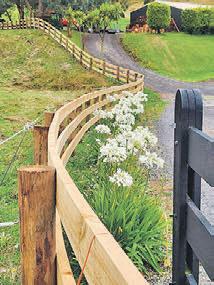
and demand has outstripped local supply – of labour and materials – so our advice to farmers is to contact fencing teams from out of area who have the skills and ability to hit the ground and get the job done.”
Sarah and Steve Collins currently run two teams of fencers, with exibility to have three teams.
“We have three tractors with buckets and back-blades for clearing fence lines and have access to heavier machinery if/ when required to clear slash and debris so fences can be resurrected. We also have vast

Abundant Health Magnesium Triple

What is Magnesium Triple?
This is a blend of 3 highly bioavailable forms of Magnesium for rapid absorption and better results.

•Marine Magnesium 121 mg

•Magnesium Glycinate 240 mg
•Magnesium Citrate 258 mg

How can Magnesium Triple help?
•These high grade forms of Magnesium are quickly absorbed to et ra id ene ts



$82.95 for 2 bottles post-free or 1 bottle $43.95 plus $5.99 postage

bottle has 120 capsules, approx 2 months’ supply per bottle.
•It is ideal to help relax sore or tight muscles
•Can help with restful sleep
•To help with PMS related tension
•Helps muscles recover after exercise
•Supports healthy heart rhythm
John Arts comments:
“Abundant Health rapid absorption Magnesium Triple can really help tight or stressed muscles and for a good night’s sleep. The 3 different forms of Magnesium mean you get fast results. The normal dose is 2 before bed.” (John Arts, Founder, Abundant Health Ltd)
experience hand-digging fences on land inaccessible by machines.

“We have a strong and constant source of supply of fencing materials with transport to any area.




“Our approach is ‘can do’ – we understand the urgency facing every farmer a ected by the deluge is facing and want to


reassure them that we’re just a phone away to talk about the challenge you’re facing and then we’ll be on your farm helping you put things right.
“ is is a time when we all pull together. Our farmers and horticulturalists have taken a hiding from the weather and helping them restore their livelihoods is our number one priority,” says Sarah.
How does magnesium help heart rhythm?
Someone I know well has been treated by a cardiologist for atrial brillation, one of the more common heart rhythm issues.
What was interesting was that the cardiologist recommended a high-grade magnesium supplement along with prescribed medications.
One paper (European Heart Journal, 2017) stated: “As such, magnesium plays an integral role in a variety of functions related to cardiovascular disorders. Reduced dietary intake of magnesium has been linked with a higher risk of hypertension, atrial brillation, ischaemic heart disease, and new-onset heart failure and heart failure-related hospitalization. Similarly, a low serum magnesium level is associated with up to a 50 per cent higher incidence of new AF, left ventricular hypertrophy, and is an important predictor of sudden cardiovascular death and overall mortality.”


Perhaps my friends cardiologist is aware of this and similar studies. e American Association for oracic Surgery and the European Society of Cardiology now incorporate magnesium therapy into treatment and management of some heart arrythmias.
As an electrolyte, magnesium has a critical role in maintaining normal electrical function in heart muscle. One study showed that patients receiving

supplemental magnesium were three times more likely to get their heart rate below 100bpm than those on a placebo. is central role of magnesium in heart muscle is because it regulates energy needed for other electrolytes, notably calcium, potassium and sodium. If magnesium is low, these electrolytes become imbalanced and can start processes that a ect heart rhythm. I use magnesium supplementation in two ways. Firstly, I add it to my multi-mineral/vitamin/ antioxidant complex. e levels in this are su cient for a healthy person. However, for those with arrythmia we need to add therapeutic levels. For this I have combined three bioavailable forms of magnesium (natural marine, glycinate and citrate) in one supplement. I then allow a dosage range of between one to four capsules daily to meet individual needs.
John Arts (B.Soc.Sci, Dip Tch, Adv.Dip.Nut.Med) is a nutritional medicine practitioner and founder of Abundant Health Ltd. For questions or advice contact John on 0800 423559 or email john@abundant.co.nz Join his newsletter at www.abundant.co.nz

Page 22
Examples of fencing completed S & S Fencing Contractors.
TO ORDER PHONE 0800 423 559
Or order online at www.abundant.co.nz Abundant Health Ltd, PO Box 8348, Cherrywood 3145
BUY!
BEST
Caution: Adult use only. High doses of magnesium can cause diarrhoea and may interact with some medications. If in doubt see your health care practitioner before use.
Each
Growing changes at Mural Town Engineering
A lot has changed since the ownership of Katikati’s Mural Town Engineering Ltd changed hands in 2022.
New managing director Tristen Cunningham says the team has grown, as has the skill base and the company is o ering a range of structural steel, residential and commercial engineering services across the Bay of Plenty area and beyond.


“We can do but are not limited to custom tractor, digger, skid steer and excavator attachments like pole grabs,
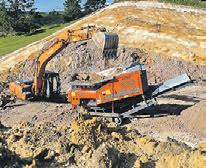




Tristen Cunningham in front of Mural Town Engineering Ltd.
Half of NZ’s rivers blocked for migratory fish
Nearly half of New Zealand’s river network is partially or fully inaccessible to migratory sh, a new study shows.
NIWA has conducted the rst nationwide assessment of river fragmentation, looking for structures that can act as barriers to sh. ese structures are often human-made and include dams, culverts, and weirs.

ey found that New Zealand has some of the highest densities of barriers to sh passage in the world, with approximately 0.16 barriers/km.
Fish passage
is works out at a minimum of 48 per cent of the river network being at least partially inaccessible to migratory sh, and a further 36 per cent that could be restricted but has not yet been assessed for risk to sh passage.
NIWA freshwater ecologist Paul Franklin says that the fragmentation of river systems is a key driver of freshwater biodiversity loss.
“ ere are just over 50 native New Zealand sh species, with around 85 per cent of those not existing anywhere else in the world. Many of our iconic shes, such as eels and the whitebait species, migrate between the sea and our rivers to complete their life cycle.
Addressing challenges
“However, they often encounter di erent structures along the way that act as a barrier, stopping them reaching key habitats. is ultimately leads to lower abundances and potentially loss of these species.”
To address this challenge, NIWA is studying the


swimming abilities of sh and coming up with solutions to help them migrate.
“We put sh into the equivalent of a water treadmill to see what speed they can maintain - we want sh to be able to move upstream casually, not having to ght the whole way. We can then assess what adjustments need to be made to structures in our river networks to help sh pass through these environments more easily.”
forestry log grabs and saws, auger attachments and drives, drum crushers, log splitters and hedge trimmers.
“We build and repair trailers, truck decks, bins, hiabs, tow bars, orchard tractors and skid steers for under-vine work including roof chops, guarding, belly pans and exhaust relocations.
“Build and maintenance work of pack house conveyors, quarry and sawmill machinery is also undertaken.
“ e MTEL team also repair and build shelter trimmers, swing mulchers and mowers, trenchers and




picking and height access machinery.
“Company facilities include a full 3D design and draughting service, fully catered machine shop including CNC and manual, mig, tig, and arc welding.”
Tristen Cunningham admitted it is di cult to quantify everything his team is capable of repairing or producing – “just give us a call so we can understand your needs and come up with a solution”.


For more information about Mural Town Engineering, visit their advert on this page.





Page 23
BIOROCK (NZ) Limited P O Box 46234, Auckland 1147 Sales: Dhivesh Krishna 021 645 717 dhivesh@biorock co nz Cer ed AS/NZS1546.1 2008 & AS/NZS 1547:2012 ONSITE WASTEWATER TREATMENT WWW.BIOROCK.CO.NZ
NIWA freshwater ecologist Paul Franklin helped conduct a national assessment of sh migration barriers. Photo: Stuart Mackay/NIWA.
Counting down to World Avocado Congress
In less than a month, 1000-plus members of the global avocado community will descend upon Auckland, for the 10th World Avocado Congress from April 2-5.
Jen Scoular, CEO of New Zealand Avocado and President of the World Avocado Congress Committee, says the number of attendees to date is incredible testament as to how highly regarded the congress is amongst the global avocado community.
“We can’t wait to welcome the brightest minds in avocados to our shores; international growers,

researchers, marketers, retailers, tech innovators, investors and more. e congress is an incredible opportunity to showcase our avocados and raise visibility of New Zealand on the world produce stage, while also demonstrating our di erentiated story to grow value and volume into developing markets.
Not just avos
“ at said, the World Avocado Congress is much bigger than avocados from New Zealand.


“It provides a once in a lifetime opportunity to sell not just the avocado industry but the New Zealand experience. We want to ensure visitors


get a real taste of New Zealand, a avour for our integrity, our innovation, our openness. How great will Auckland feel with that many people visiting, many who have never been in NZ before, wining and dining in the city?!”
Twenty-seven countries are represented amongst the almost 1000 avocado stakeholders attending, with more than half coming from outside of New Zealand and Australia. e World Avocado Congress will be one of the rst and largest global trade events to be held in New Zealand following the opening of borders after the pandemic.
Global future
A core focus for the next World Avocado Congress is to address how sustainable the global avocado industry is across people, environment and economics.

“ e theme for the 10th World Avocado Congress is Respectful; respect for people, respect for environment and respect for our future. Respect for people and the land plays a special part in Aotearoa New Zealand’s identity, it underpins who we are as a people and a nation.
“While the term ‘sustainability’



has become a trendy word in recent years, it’s essential we demonstrate a committed, and not tokenistic, approach. To ensure the sustainable growth of the global avocado industry, we all need play our part in this global conversation.”
Dream realised
e programme for the congress will be announced shortly. e congress will include a three day academic programme with international keynote speakers and three programme streams covering a wide range of avocado topics from breeding and genomics, to agritech innovation, pest and diseases, country reports, sustainability and more.


“Since 2015, New Zealand Avocado has been wanting to host a World Avocado Congress. at dream became a reality in 2019 when we won the rights to host the next congress, beating Mexico, the largest avocado exporter in the world.
“Over the past few years, our team have worked incredibly hard to promote the congress across the world. With only a matter of weeks to go, the countdown to the congress is well and truly on!”
For more information or to register visit the World Avocado Congress website: www.wacnz2023.com/home
Page 24 AVOCADOS
•Aerial Survey •Aerial Lifting •Agricultural Seeding •Agricultural Spraying •Agricultural Topdressing • Charters and Sightseeing •Fire Fighting • Frost Control •Photography and Filming � for Facial Eczema Spraying LET’S WORK TOGETHER! Our experienced and hardworking contract teams work year-round to help produce the best Avocados for domestic and export markets. get in touch at: (07)549 1809 or info@aaltd.co.nz Grow Harvest Pack Manage
Tunneling avocados inTe Puna
year for controlling pests. e average orchard would usually put on about 15 to 18 copper sprays, and about 14 to 15 insecticide sprays. e cost of spraying is a tenth of what it would be outside. For fertiliser, the cost is about half. We don’t need to put on a lot due to our controlled water keeping the fertiliser in the root zone.”
If there’s any concern with sustainability with plastic coverings, Phil says his shelter is completely environmentally friendly, with recyclable materials being used across the board.


“Everybody thinks plastics and tunnels are not very ecological.
“Along with the plastic and steel being fully recyclable, we use water, less fertiliser and less chemicals going on in our trees. So there’s a whole lot going on which makes sheltered avocados more ecological than an outside production.”
Nowadays when customers approach him to buy his avo’s, they speci cally request the ones grown under the shelter, according to Phil. “ ey’re usually a lot bigger compared to the outside ones, and the avor is just outstanding.”
To learn more about Phil’s exciting new avocado growing method, visit: www.quiedan.co.nz/
Avocado yields just got a whole lot more consistent. For the past ve years, Te

Puna’s Quiedan Tunnels co-owners Phil Reed and Adrian Hoggerburg have worked to create dependable yearly harvests for the avo industry, in a way that is largely hard to miss. Readers may have seen the massive tunnels on display whilst driving near Minden on State Highway 2, completely unaware such a structure has been put in place for the oily fruit. But for Phil, the outcome himself and Adrian are seeing is very much worth the e ort. He says inconsistency between yearly harvests is causing the industry to largely ‘miss out’ on its maximum pro t potential, but this may soon be a thing of the past thanks to this new method.
Steady owering
“ e key thing with avocados is they are quite biannual, meaning one year you get a really big harvest and not so much the next. With the tunnel growing model we are trying to make the yearly harvest more even, because it’s hard to get money when you are only getting good
crops every second year,” says Phil.
“We had a feeling this new growing method would help and it certainly has.”




Phil says outside, avocado trees tend to ower more heavily, whereas when grown inside, the trees ower more steadily.
“If they have a really big crop, there’s really nothing left in the system to be able to grow ush, which gives you ower for the following year.
Crucial elements
“Under the tunnels, the ush tends to come about three to four weeks earlier, so by owering time it’s already about six to eight inches long, which means you can ower for the following year. We’ve had consistent crops for about ve years now.”
Avoiding impacts from weather is another crucial element to successful avocado growing according to Phil, which he says he is able to mitigate with his tunnel shelters.

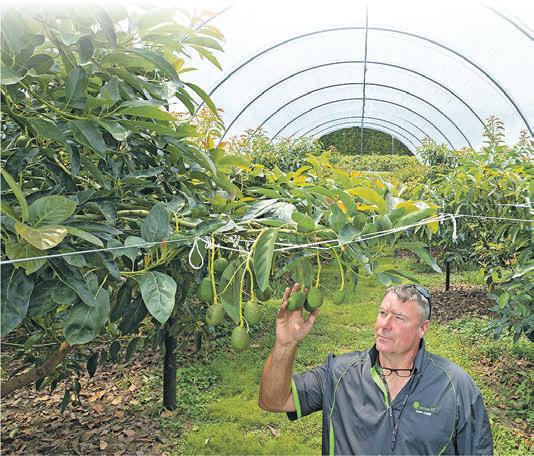
“During owering, the temperature needs to stay above seven degrees, minimum. From the time the ower is pollenated, to the time of growing of the pollen tube which fertilises the
seed takes about four days.”
“If at any point there is a cold snap below 7 degrees at night or during the day, the pollen tube stops from developing and basically aborts all of the owers.




“ is is what happened to a lot of growers this year, there was a lot of temperature drops.



“However under the tunnel it is a lot warmer and we were able to prevent this from happening.”

Phil adds a key to any business is how it can turn over pro t.
He says during his harvest, he is able to get “very little” second class fruit, meaning he receives more pro t per crop.
“What we’re doing here is increasing production and decreasing cost. Harvesting is the number one cost to the avocado industry, which for outside trees, will run at roughly $150 a bin.
“Our method makes the avocadoes a lot cheaper to harvest, and by our estimations it will cost between $40 and $50 per bin of avocadoes harvested.”
Saving on spray and fertiliser is another bene t to Phil’s growing method. He is able to use less spray as he can control how much water the avocado trees receive, and not have it washed away by weather.
“We only put on four sprays last

Page 25 AVOCADOS
Phil Reed and his team at Quiedan Tunnels have devised a way of making avocado yields more consistent.
Photo: John Borren.
Taylor Rice
FOR KIWIFRUIT JOBS
NEW ZEALAND Everything grows better with structure
Maximising avos: Channel selection key




Darling Group and their avocado supply arm, Just Avocados, have completed the New Zealand avocado export season and released a summary of returns to their growers for the early season pool.
Although returns as an industry are lower for a second season in a row;
Jacob Darling, Darling Group’s chief operating o cer, says a positive for their business, and Just Avocados suppliers, is that they were able to pick, pack, and sell all their growers’ fruit across all grades and sizes.
He adds that not all packers/
Darling Group maximised value for Just Avocados growers in a season where there was a high volume of lower grade fruit.
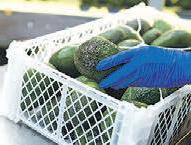
exporters were able to achieve this.
“To do what we have requires a close working relationship between our export and domestic sales teams, access to all levels of the supply chain both internationally and domestically, and an understanding that in a tough quality year we have to maximise opportunities and values.”
Class 1 fruit volume this season was low at an industry gure of approximately 45 per cent.
Process grade was particularly high across the board at 22 per cent. Darling says Just Avocados process gure was only 12 per cent.
Darling says diversity in their business allowed them to mitigate the worst impacts of another extremely di cult season and nd value for the higher volumes of lower grade fruit.
Looking ahead
is season Darling Group was the leading exporter by volume for diverting lower quality grades to higher value o shore channels.
“Exporting Class 2, 3 and process grades to the appropriate channels o shore yielded better results for growers than a strategy of Class 2 to domestic and Class 3 to oil.”
Darling Group comprises J.H. Leavy & Co. based in the Australian market and Zeafruit who focus on domestic sales, they also have plans underway to set up an o ce in Asia to support the growth of their avocado sales in China and Hong Kong.


Looking ahead to 2023-24 season, Darling says their focus is to continue to maximise total crop value through nding value for all their growers’ fruit; improving tonnage per hectare and quality
levels on orchard to improve class 1 pack outs; and monitoring costs across the supply chain including those on the orchard.

Darling Group is also keen to keep growers engaged amid mounting compliance.
“ e Just Avocados team is looking at new ideas and di erent options around compliance such as GLOBALG.A.P. to enable all growers to stay involved and be pro table in the industry.”
Of future seasons, Darling says market dynamics have shifted and that there are many new norms that growers should start considering.
Export future
“ e future of export for the New Zealand avocado sector is not the traditional late Australian window. We see ongoing challenges in that space with continual production growth in Australia, Chile targeting the post-Christmas window in wholesale, and the early Shepard crop chasing a bigger slice of the early new season window.
“As an industry our export window will tighten, and we have to have the capability to pick, pack, ship and market larger tray volumes in tighter time frames.”
Darling says this will require growers to partner with companies who o er a simpler, integrated service from orchard to consumer.
“Growers that partner with the right companies will give themselves the opportunity to maintain pro table. e market access variance between companies is not equal and that will be tough for some growers to work through.”

Avocado harvest interrupted
e tail end of New Zealand’s $150 million avocado export season has been cut short by last month’s torrential rain.
Seeka grows and exports avocados grown in Bay of Plenty and Northland, and chief executive Michael Franks says it wasn’t safe to operate harvesting ladders on extremely waterlogged ground.


He says export volumes will be down because the window for sending fruit o shore will close before harvesting could pick up again.
“We will probably miss the window to ship to Australia so the remaining fruit will go into the domestic market when we can get to it.
“I’d say about ve per cent of our export crop won’t go o shore, but still the export market returns are much higher than the local marketprobably double.”
is was the third year in a row growers have had low returns and some will be losing money, he says.
Page 26 AVOCADOS
Midge Munro, Darling Group
It’s nearly that time of year! Autumn is the best time to inject your avocados, and after the wet winter and spring we’ve had, injecting will be important! Don’t miss out, get your Avojects now at: avoject.co.nz info@justavocados.co.nz Call John Emett Grower Services – Northland, Tapora, South Auckland 027 476 9087 Kyra Fielden Grower Services –Bay of Plenty, Coromandel 027 257 5028 Join Just Avos. justavocados.co.nz @justavocados WE PICKED, PACKED, AND SOLD EVERYTHING. And we’ll do it again.
Avocado growers hammered by Cyclone Gabrielle


Trees in Garry Cli ’s orchard in Northland were dislodged by extreme winds. Supplied/Stu .
Next season’s avocado crop has already been extensively damaged by Cyclone Gabrielle, say Northland growers.


Maungatapere avocado grower Mike Eagles says next year’s avocado harvest is “already hopeless” because of the damage the fruit and trees had sustained from rain and wind.
His 10-hectare orchard was “absolutely hammered” by the morning of February 13, with rain gauges over owing a day before the worst of the cyclone was expected.


Ripped away
Mike found branches torn from trees, small trees uprooted and fruit that would have been harvested in August for next season’s crop scattered on the ground. He says that amount of fruit loss will have a signi cant impact on the income from the orchard. Fruit will be downgraded to lower quality grades, he says.
Avocado fruit is graded on three levels. e best quality fruit is exported and earns about $13 or more per tray. Fruit consumed locally earns about $5 per tray, and the lowest grades of avocado are processed into avocado oil, paying much less, says Mike. In a good year, about 80 per cent of Mike’s fruit
would be exported but only about 40 per cent was exported last year because of another severe storm. He expects even less fruit would be good for export after Cyclone Gabrielle.
e wind and rain began on the east side of the farm, but later swung around and came from the south, and as a result the orchard received damage from all sides, he says.
Other fruit growers also felt the impact of cyclone Gabrielle.

Gary Cli is also from Maungatapere, where he grows 50 hectares of avocado.
When he inspected his orchard on Monday, February 13, he found some trees were completely dislodged. ere were also a lot of fruit on the ground, he says. Constant rain this year has caused tree health
issues, and he expects it to get worse after the cyclone.
A lot of the fruit left on trees would be damaged, although it took a week for fruit to show scars, and he could not determine the extent of the damage yet, he says.
August harvest
e damaged fruit will only be harvested in August, he says. Most fruit will have been damaged so much that it could not be exported. A cold spring last year meant a lot
of the trees carried their fruit higher, which has exposed it to the e ects of the storm more, says Gary.

In order for a grower to pay back what they spent on growing, and make some pro t, they needed to be able to have a large portion of export-quality fruit, he said. Although such extensive damage is bad for growers, it will bene t local consumers as there could be plenty of fruit available on the local market, he says, which could push down prices.
Call



You

Soil classification gives you the “blueprint” and potential of your farm. This is invaluable for existing orchards and new developments.


Giving you insight for better crops by:
• Identify and assess root health and irrigation efficacy

• Allocate ideal soil moisture probe placement




• Recommend intervention strategy for suboptimal performing areas
• Identify areas that require drainage (directly linked to plant health)





• Recommend cultivation techniques to alleviate potential root limiting issues

• Identify leaching zones so you can manage them

•

Page 27 AVOCADOS
- Gerhard Uys/Stuff.
Your Solution for all things Irrigation
Avocado growers are expected less fruit to be exported this year due to being damaged by the severe weather.
Our Experts on 0800 130 905
www.irrigationexpress.co.nz
don’t know what you don’t know –BUT YOU CAN!
your soil’s status, contact your nearest Agri Technovation specialist at - 09 954 5411
Technovation – The precision farming people. (See you at WAC 2-5 April Auckland) Add precision Agriculture by: • ITEST TM SOIL for nutrient insights
ITEST TM MICROLIFE to manage soil health
Know
Agri
•
ITEST TM LEAF to treat areas where needed
Nutrient requirements after a wet summer


With relatively dry summers and autumns for the past three years, I have not been too worried about many of my dairy farmer clients in the Waikato region only applying fertiliser once a year in the spring.

is is because there has been little nutrient removable from pastures over the dry period, and with maintenance potassium best applied in the SeptemberDecember period along with some phosphorus and other elements, soil reserves are not depleted as much compared to wet summers.

On top of this, many farmers are purchasing


additional nutrients in the form of maize and grass silage, PKE, meals, grains, and produce wastes such as kiwifruit, potatoes and onions. All of these additional supplements contain nutrients that are deposited onto dry pastures via dung and urine, and subsequent soil audits show no major decline of fertility levels from just once a year applications.
Exception is season, however, will be an exception, with a much wetter spring than normal followed by regular rainfall heading into summer, delaying the harvesting of silage and hay crops, and with cyclones Hale and Gabrielle bringing further deluges, soil moisture levels have remained high, keeping grass green and fresh.

With lots of rain, soluble nutrients such as nitrogen, sulphur and potassium are leached more readily, so reserves can become easily depleted. Phosphorus on the other hand does not leach except on raw peat soil and podzols, so will remain in the root zone, but with proli c grass growth the store of phosphate in the soil will also decline more than in a dry year.
Observation

As I drive around the countryside observing maize crops, many have been water-logged and others are su ering from nitrogen de ciencies and possibly other elements.
One tool for looking at nutrient requirements in maize crops this past spring has been getting available

nitrogen tests done through local laboratories, and where these have shown to be good, the amount of nitrogen recommended as a sidedressing can be reduced, particularly when nitrogen prices have been as high as they are this season.

Sulphur and potassium inputs into hungry maize crops have also been minimal on some properties this year because of a more than doubling of their prices, and again with all of the rain, some crops will be su ering from these de ciencies.
Had it been a normal dry summer, the standard nitrogen, potassium and sulphur inputs would have su ced, but with much more leaching, more of these elements should have been applied. Hindsight is a wonderful thing.
New fertiliser


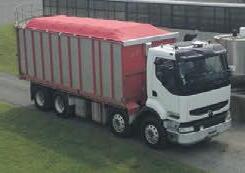
A relatively new potassium fertiliser which has been imported and sold by some smaller companies is a product known as Phosta K, but also marketed by other names; which is a potassium sulphate/carbonate product. It is a by-product of the sugar cane industry in Indonesia and is allowable under organics. Unlike standard muriate of potash (potassium chloride) which is readily leached, the potassium in Phosta K is slowly released, along with small amounts of sulphur, phosphorus and magnesium which it also contains. I had two dairy farmer clients, one on pumice and the other on peat, which are both soils that readily leach potassium, who tried this product two years ago. Both clients commented that 12 months later their farms had never looked so good, and one who I have been providing advice for more than 30 years, I commented back in August when taking more soil tests that I had never seen such good clovers on his property and he agreed that the farm was looking better than he had ever seen it. We put this down to this slow releasing potassium product.
Wet summer
After such a wet summer, it would be wise to re-evaluate soil nutrient reserves, and possibly get fresh soil tests taken if they haven’t been done for a while, and take stock of fertility levels. e costs of soil testing is only a tiny fraction of the current cost of fertilisers. In 2020, potassium chloride was being sold for $660/ tonne by the two big fertiliser co-ops, whereas now it is $1550/tonne, largely as a result of the Ukraine war with both Belarus and Russia, major exporters of potash, having embargos against them. Also the form of potassium going into the winter with wet conditions should be considered, and anecdotally Phosta K appears to be a good option.


POWERTARPS ARE NEW ZEALAND’S LEADING RETRACTABLE TARP SUPPLIER




















We specialise in high quality, mesh and PVC covers to suit trucks, trailers and farm bunkers. All of our covers can be easily operated from the ground using a silky smooth cable system, eliminating health and safety risks.

Page 28 FERTILISER
Robin Boom, Member of the Institute of Professional Soil Scientists 027 444 8764.
e e ects of a wet summer are being felt all over New Zealand.
Photo: NZDF.
Robin Boom CPAg MBSPC Independent Agronomy & Soil Fertility Consultant
Necessities for superior soil biology

available for plants. Excess calcium has suppressed it. Lower calcium to 73 per cent to end up with 12 per cent magnesium. When soil calcium is below 60 per cent, however, the soil will

to move out. De ciencies are far easier to deal with than excesses. It is a matter of adding the correct kilograms of material that will raise the nutrients in the soil. Dolomite will raise both Ca and Mg in the soil.
carbonate, correct amounts can be calculated to reach the selected soil percentages over one or several years, to suit economic circumstances. For further information see Kiwi Fertiliser’s advert on



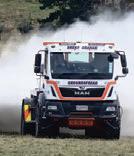





Calcium and magnesium should both form the basis of soil fertility programmes.

Other nutrients are more e ective when calcium and magnesium are at optimum levels.
ey are vital for soils, microbes, plants, and animals alike. De ciencies or excesses of either result in serious economic consequences.
Base saturation

e percentages of Ca and Mg on a soil’s base saturation are critical to the success of any growing operation. Don’t let anyone tell you it is a ratio. It is not.
An ideal soil is 45 per cent mineral, ve per cent organic matter and 50 per cent pore spaces occupied equally by air and water.




Calcium and magnesium are the minerals that determine this pore space con guration in the soil.





In turn that determines the physical drainage characteristics and water/air holding properties of that soil.





Too much Mg will mean too much water and not enough air. at may mean suboptimal conditions for bene cial microbes, or optimal conditions for diseasecausing microbes.



Too much Ca will translate to too much air, dry soil, and de ciencies of other nutrients. ( is can happen when Gypsum and lime are used without reference to soil testing for calcium.) Optimum pore space then translates to an ideal environment for soil biology to thrive.
Having correct Ca and Mg will



increase the rate of carbon sequestration in the soil.
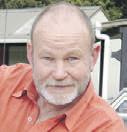







Plant yields are not only determined by soil nutrients, but also by root depth. Without the correct soil structure, high yields of quality will not happen. It is mandatory that calcium and magnesium be correct for the soil to be in top condition.
On a Perry Agricultural Laboratory (PAL) test, in most soils, calcium needs to be at 68 per cent and magnesium at 12 per cent. In lighter soils, the amount of magnesium increases, while calcium decreases. Magnesium holds water better than calcium owing to the smaller size of the atom, giving a larger surface area.
Relationship

Soils with inadequate Mg will dry out faster. e total per cent of Ca and Mg should not exceed 80.
It is the percentage that determines mineral adequacy, not the kilograms. Crops respond in di erent ways when the ideal percentage is not achieved.
If magnesium, a determinant of nitrogen and phosphorus e ciency, is outside 10-12 per cent, maize yields will re ect that by tapering away from the optimum. With other plants, the yield reduction can be more abrupt.
e relationship between calcium and magnesium is direct. A soil with 80 per cent Ca and ve per cent Mg still has Mg there, but not
Grass Pond Cow
Strong


Grass Pond Cow








Page 29 FERTILISER
Soil Testing Fertility Advice Fertiliser Recommendation Feed Quality Assessment Total Replacement Therapy E uent Management Remedial Advice & Action Slurry Bugs & Product Feed Management Plan Feed Balancing Pasture Management Feed Budgeting Ultimate Liquid Caustic Ultimate Acid DX50 Dairy Sanitiser DX50 Water Treatment
Soil BioCircle
healthy biology is transferred from one area to another. This biology improves every area it enters. the Ron McLean: Managing Director | Kiwi Fertiliser M: +64 27 289 4258 T: 0800 549 433 E: ronmac@kiwifertiliser.co.nz www.kiwifertiliser.co.nz David Law: Director | Kiwi Fertiliser M: +64 27 490 9896 E: david@forwardfarming.co.nz www.totalreplacementtherapy.com
biological life in all areas of the farm Soil Testing Fertility Advice Fertiliser Recommendation Feed Quality Assessment Total Replacement Therapy E uent Management Remedial Advice & Action Slurry Bugs & Product Feed Management Plan Feed Balancing Pasture Management Feed Budgeting Ultimate Liquid Caustic Ultimate Acid DX50 Dairy Sanitiser DX50 Water Treatment
Our mission is to respect
Soil Ron McLean: Managing Director | Kiwi Fertiliser M: +64 27 289 4258 T: 0800 549 433 E: ronmac@kiwifertiliser.co.nz www.kiwifertiliser.co.nz David Law: Director | Kiwi Fertiliser M: +64 27 490 9896 E: david@forwardfarming.co.nz www.totalreplacementtherapy.com
mission is to respect biological life in all areas of the farm Healthier soil makes healthier horses Visit us at www.cplimesolutions.net.nz or call 0 508 678 464 for more information Obvious, isn’t it? Equilise helps take care of horses by looking after the soil.
Our
Powerful probiotics reduce weight loss after calving





High producing cows will lose weight after calving even though they are fully fed. ey must mobilise fat reserves to meet the demand from milk production.
However, recent international research con rms that a powerful probiotic substantially lowers this weight loss.

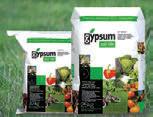








“In one particular trial they measured an indicator in blood samples that con rms cows are mobilising fat reserves,” explains Matt Collier from Probiotic Revolution.
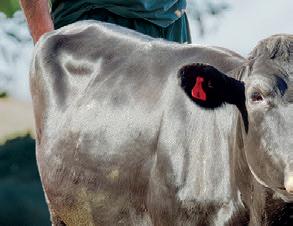
“Because this indicator was substantially lower around calving it means cows are digesting their feed better before and after calving with implications on health at calving, early production and a shorten interval from calving to rst heats.

“We are able to feed the right strength of probiotic to mimic results obtained in the trial and have seen the results in numerous herds here.



“In the past we have focused on using our products to reduce calving mastitis, but it is obvious that a powerful probiotic will also improve a wide range of health issues.

“We have farmers reporting far less calving di culties, signi cantly higher volumes of colostrum and very little weight loss in the six to eight weeks after calving.

“One farmer, in the rst year on our program had 95 per cent of his cows cycling by the planned start of mating – a record for him and an indication that improved digestion follows through with a better outcome for early cycling of cows.”


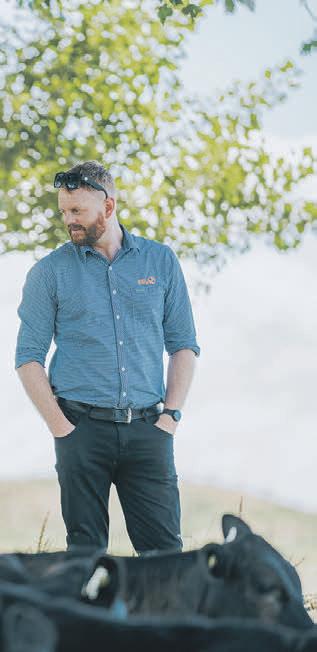
Probiotic Revolution’s probiotics are best started with springers on a daily basis in a pre-calving mix or in the water trough.
After calving there are three options – to suit nutrition, and mastitis and cell count objectives.



Page 30 DAIRY
|IMPROVEHEALTHDURING |MINIMISINGWEIGHTLOSSAFTER GOODBUGS FORCALVING
Researchshowsapowerful probioticcan: Lowermastitisand cellcounts significantly Substantially lowerbodyfat mobilisation Lowercortisol& stresslevels Colostrum volumesup Lessweightloss Shortened intervalstofirst heats ~DISCOVERTHEMISSINGINGREDIENT Resultingin Available at: It all starts with healthy soil. 100% natural calcium and sulphate sulphur source. Ideal as a supplement pre and post calving, reduces pugging, soil compaction and phosphorus run off. For more information go to gypsum.co.nz
Matt Collier investigates mastitis breakthrough.
WWW.PROBIOTICREVOLUTION.CO.NZ LET'SCHAT; |CHRIS0274591061 |MATT0212341713
Makes friends wherever it grows
Once established, cocksfoot has good tolerance of all pasture pests. Notably, it is much more tolerant of grass grub than ryegrass.
Seed for Rede ne is available now for autumn sowing. Order yours from your seed merchant today.
Great news for those of you who want to get more cocksfoot into your pastures this autumn – there’s now one available that mixes well with other species instead of taking over.
Rede ne is tailor-made for anyone who wants the bene ts of cocksfoot without the clumpy, aggressive behaviour and clover suppression often associated with older varieties.





at means you can add diversity and climatic resilience to summer-dry pasture mixes, because cocksfoot
is tougher than ryegrass with more summer growth.

Since Kara was released back in 1980, we’ve made great progress developing ner, more tillered cocksfoot cultivars. Rede ne is another big step forward.
At more than 5000 tillers per square metre, it has more than twice as many tillers as Kara.

You can clearly see the di erence between it and other cocksfoots.
Clover friendly
Rede ne is a better neighbour for clovers than older cultivars, and clover returns the favour by feeding it with naturally- xed

nitrogen. Why does this matter?

Without enough nitrogen, which shows up as yellowing leaves, cocksfoot becomes low in crude protein. It doesn’t taste great; your animals don’t enjoy eating it and their performance is a ected.

Great team-mates
Rede ne and ryegrass are ideal partners, giving more reliable pasture establishment than sowing cocksfoot as the sole grass. Rede ne sown with ryegrass will be faster to grazing than cocksfoot only, with fewer weed issues and it will provide more feed over the rst year.

Alyce brings hands on experience to DairyNZ

DairyNZ’s new strategy and investment leader, Alyce Butler, is excited to be working on solutions to key dairy sector issues, with a particular focus on sta shortages and dairy careers.

“We are thrilled to have Alyce join us from her most recent position as director for Future of Food at Monitor Deloitte in Amsterdam. Alyce was raised and worked on a dairy farm in Taranaki, bringing hands-on experience of the responsibilities, opportunities and challenges facing our sector, and an optimistic outlook of what we can achieve,” says chief executive Dr Tim Mackle.
“We are lucky to have someone with a global perspective and wealth of knowledge join our
leadership team, as DairyNZ continues to work with farmers to deliver our vision of a better future for New Zealand dairy farmers.”
Alyce will be focused on delivering solutions for on-farm capability and consider how DairyNZ can engage and partner better with farmers.
“One focus for Alyce will be on closing the labour and skills shortage gap, which continues to be a key concern for farmers. She will be helping our team to deliver solutions that attract and retain people in dairy farming.
farmers. She will be helping our team solutions
“ is includes our Great Futures to as a competitive career option through a range of workplace and












“ is includes our Great Futures in Dairying plan, to shape dairy as a competitive career option through a range of workplace and technological advances.”



Alyce is excited to return to her farming roots and having the opportunity to support farmers, helping them feel more con dent.
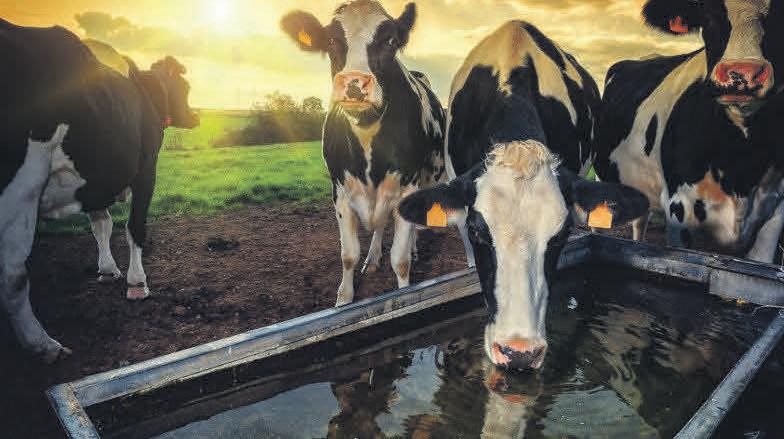
Page 31 DAIRY
Paul Hames, Barenbrug area manager
An example of cocksfoot.
EFFECTIVE RETRACTING COVER SYSTEMS Keeps feed or fertiliser dry Winch system for easy access Canvas or steel cladding options Save time and cut waste
262 788
@BarenbrugNZ facebook.com/BarenbrugNZ barenbrug.co.nz The ultimate mixer. Redefine
0800
info@slidingroofs.co.nz www.slidingroofs.co.nz
cocksfoot
Peformance is everything
It’s easy to xate on detail and become embroiled in meaningless debate. I’ve been at discussion groups when people wanted to claim that an Olsen P level of 25 was better than one of 15, or the ideal soil pH is 6.3 rather than 5.9.
Any soil test number is meaningless until put into context. ere’s a large amount of extra information required before any single measure is worth spending thinking time on.
Money
Fertiliser costs money and of late it’s become increasingly expensive, a situation that is unlikely to change this autumn, therefore it’s essential to know what the aim of applying fertiliser is. In the short term if there’s not available money, or it can be put to better use, sitting tight might be the best option.

Where fertiliser has been regularly applied phosphorus inputs will almost certainly be higher than maintenance and not applying this autumn is unlikely to limit production over winter and spring.
Potassium falls into the same category.

Plant availability of potassium when soils are su ciently moist for maximum growth is likely to be adequate over autumn, winter and early spring.
It’s not so clear cut with sulphur, particularly in the South Island on low ASC soils, typical of all but volcanic soils.
Weather


Under heavy rain, plant available sulphur can leach rapidly and unless elemental sulphur has been regularly applied, a growth limiting sulphur de ciency could occur in spring.
Withholding nutrient inputs for longer is likely to be false economy with the cost of lost production greater than the money saved.
As fundamental to optimum growth as the nutrient status of the soil, is the rate at which nutrient is being cycled. Early research identi ed and much has been written on the factors that in uence the Rapid Organic Cycle.
Essentially, it’s the speed at which nutrient from unavailable sites becomes available for plant uptake that’s important which in turn is reliant on the activity of bene cial biology.
Depending on which nutrient is the focus as little as one per cent is plant available and seldom more than ve per cent at any point in time.

ere are two factors that have a major impact on nutrient cycling that farmers can in uence.
One is physical soil structures. Ideally soil should contain 25 per cent air and


to achieve that it is essential that there is a su cient interval between grazings for soil to regain their optimum structure.
In periods of excess rain animals will cause damage, it’s inevitable, with the only choice being whether the mess is con ned to a small area that can be sorted at a later date, or creating a lesser problem over a larger area.

Spreading animals out means the damage is less obvious, and natural recovery will follow however there will be some impact on future growth during that time.
e other is ensuring su cient calcium to maximise bene cial fungi, bacteria, and earthworm activity.

Functional Fertiliser makes CalciZest, a product proven over 25 years to stimulate


soil biology, increase clover growth and improve physical soil conditions.
Due to the inclusion of a wide range of bene cial soil microbes the response is rapid with a greening in pasture often obvious within 3 weeks after application provided there’s su cient moisture for strong growth.
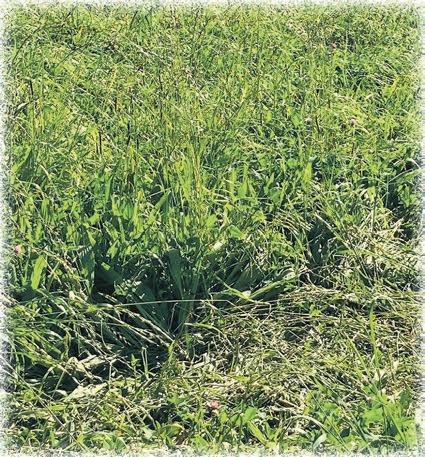
It is the release of nutrient from dung, old root, and leaf on the soil surface that provides the nutrients, including nitrogen, for strong autumn growth.
After a summer dry spell bene cial soil biology is at a low ebb and by applying calcium along with immediately active bene cial soil microbes an increase in the speed of pasture recovery is guaranteed. For more information call Peter on: 0800 843 809.
You can say for sure, when it comes to quality and performance, Boehringer Ingelheim cattle products will keep your stock at their very best. Equally, this cookware by Zwilling is known to outperform expectations and designed to handle any recipe for success.

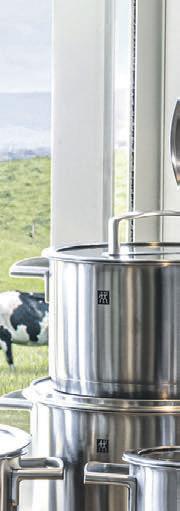

Page 32 DAIRY
Strong autumn growth in March 2022.
Receive a FREE * Zwilling 5 piece Cookware set or Frying pan, when you purchase qualifying Boehringer Ingelheim cattle products this season. Ensure young stock become future high producers through improved health, growth and energy at: futureproducers.co.nz Boehringer Ingelheim Animal Health New Zealand Limited. Level 3, 2 Osterley Way, Manukau, Auckland, New Zealand. ECLIPSE , EPRINEX , GENESIS , IVOMEC and MARKS-MIN are registered trade marks of Boehringer Ingelheim Vetmedica GmbH, used under license. Registered pursuant to the ACVM Act 1997. No’s A010640, A011151, A007191, A009888, A006481, A011687. © Copyright 2023 Boehringer Ingelheim Animal Health New Zealand Limited. All rights reserved. NZ-CAT-0019-2022. *Promo ends 30th April 2023. While stocks last. Ask in clinic for qualifying products.
Historic summer rainfalls recorded
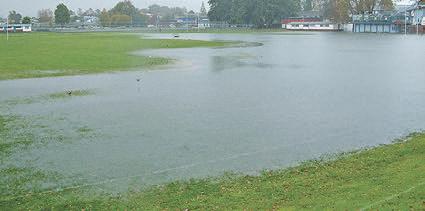

It literally is a game of two halves for the country’s agricultural industry right now (February).
Cyclone Gabrielle has created immeasurable damage across Northland, Auckland, Coromandel, the Eastern BOP and Hawke’s Bay, while the rest of the country has been virtually unscathed. at stark di erence could eventually be a saving grace because the reality of deluges of rain is loss of pasture and crops, i.e: loss of production and pro t contrasting with the abundance of growth many farms are experiencing and this stark di erence could be a ballast for farmers who have literally lost everything.
Let’s hope so. It’s at times like this that the strength, resilience and drive to help those less fortunate unites Kiwis.
But onto the reality on our farms.
Rainfall
So far this month we have had 123.5ml of rain. ere has been 337.5ml since January 1 in comparison with 224.5ml for the same period last year. e soil temperature is signi cantly di erent to last year too. Last week, the average temp was 20 degrees compared to 23.5 degrees for the same week last year.
At the farm we have had 359ml so far this month. Year to date we are up to a whopping 1148.5ml which is ve times more than we had in the same period last year! In fact – we have already reached the total that fell from January-June in 2022!

Fortunately, we escaped Cyclone Gabrielle with minimal damage. e January deluge a ected us much more with slips over fences and ooded maize paddocks. Compared to the rest of the country, we got o lightly.
Crops
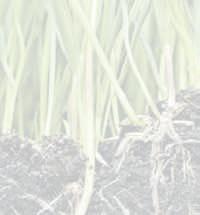


I have been talking to one of the largest contractors in Hawke’s Bay who we source feed from and he said his yards were ooded with silage bales oating but, thankfully, no water above tractor motors and/or batteries – so he was optimistic most




of his machinery was operable. Due to access issues, with impassable roads and bridges down, he hadn’t been able to check on his crops.

He provided one illustration of the personal impact of road and bridge closures with one of his friends, who was staying near Rotorua at the time of the cyclone, faced with the only route to Hawkes Bay being through Palmerston North!
Historic rainfalls have been recorded this summer. and beyond, but the word I’m getting is that the biggest need right now is people-power to clear fence lines (buried under sludge) and reinstate and repair fencing. e prospect of a student army of volunteers springs to mind and I am sure that resource will come forward once access is re-established.
A contractor in Te Awamutu said some areas of his maize paddocks are wetter now than they were in the planting season. Another, further down the island had 100 acres of red clover, which was about to be baled, completely submerged.



Pinch point



As things stand in February, a majority of farms (outside the ood a ected areas) have surplus grass which, in a normal year, would be harvested as hay or silage but, due to extreme rainfall, has not been able to be harvested.


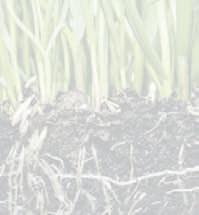

At home we will attempt, for the second or third time, to get onto saturated paddocks this week, to try and harvest some hay. If the ground is still too wet for machinery we will either have to hope we can harvest the grass for silage or put dairy grazers on over winter.
We have some loads of hay coming in from the Central North Island but again, this depends on the ability to get onto paddocks and harvest.
Assistance for Hawke’s Bay
We have been contacted by farmers with surplus feed who want to help their counterparts in Hawke’s Bay



Maize supplies
We still have a bit of maize on hand. With the potential for limited supplies. My message to farmers is to get their
orders in early for winter feed i.e: maize, straw or hay.




e past 12 months have thrown the book at the agricultural industry – from untimely frosts on orchards
to torrential rain and hurricane-force wind impacting a devastating e ect on lives and the bedrock of farming. We are well overdue for some good times.
Page 33 DAIRY
Providing cyclone relief
After the destructive impact of Cyclone Hale, Rural Support Network have partnered with Greenlea Premier Meats’, and their Greenlea Foundation Trust, alongside Repost Fence Posts.
ey provided multiple truck and trailer loads of repurposed vineyard fence posts to cyclone hit rural farmers across New Zealand.

Rural Support Network contacted Repost as their lowcost posts allow donations made by Greenlea Foundation Trust to go that much further.

“Areas have been hit extremely hard by the cyclones, regions have su ered extensive damage from a lot of slips and damaged ats, resulting in many kilometres of fencing which will need to be replaced,” says East Coast Rural Support Trust chair

Mud and silt left after oodwaters subsided. A calf standing alone after the oods.
Clint Worthington. Greenlea Foundation Trust was setup for this exact purpose, to help communities get the immediate help and support they need after the impact of Cyclone Hale and now Cyclone Gabrielle. Repost recycle the viticulture industries’ broken CCA treated wooden vineyard posts, and
repurpose them into farm fence posts (from $3.25), saving them from land ll. See the advert on page 2.
Farms and farmers a ected by the recent cyclones should contact the Rural Support Network.

Contact: 0800 787 254 or nd your closest regional help at: www.rural-support.org.nz/ Regions

Surveyors help in cyclone recovery
Surveying Services might be subdivision specialists and spend a lot of our time subdividing land and creating new titles but, following a natural disaster, we can help with many land-related issues. Our team can assist with anything that has to do with measuring and mapping the land.
e huge database held by Land Information New Zealand is available to us when we are called upon to show people where their boundary is when the landmarks have been displaced.
Land titles
Your titles are guaranteed by the Crown and our Licensed Surveyors are quali ed to place new o cial boundary pegs. Slips, oods and earthquakes change the landscape, but not the boundaries.
In extreme cases land, houses and other assets are strewn across the landscape onto other people’s titles and part of your land might be unrecognisable.

We can re-establish your boundaries for you to fence your land.
Surveyors are called upon by local authorities and insurance companies to survey the extent of damage and provide maps that can be used to design remedial construction. Our technology these days allows us to survey many sites without putting our team at risk.
Scanning a slip from a remote location or drone survey techniques help us out here.
Often as a preventative measure, we assist geotechnical engineers and building companies by preparing site plans that enable them to assess the slope stability risk and to build houses a suitable distance back from any hazard such as a steep hill, river or manmade infrastructure.

Natural disasters
Following natural disasters, there is often damage to major infrastructure or threats of subsidence. Securing these assets, monitoring movement and providing solutions, all require surveying input from the outset.
Nationwide, surveyors are ready to assist with this work and have formed a network through their national organisation, Survey and Spatial NZ. rough this initiative, resources can be deployed urgently as needed to any region in need.

If you’re experiencing some damage following the devastating weather that has hit the region over the last few months give us a call and we’ll see if we can help.
If we are unavailable, we will do our best to refer you to someone who can help you.
Page 34 DAIRY
Flooding in the Waikato.
Photo: Kelly Hodel/Stu .
GRUNDFOS ®
Critical kiwifruit chemical reclassification
A ‘critical’ chemical for the kiwifruit industry is no longer being proposed as becoming a classi ed carcinogen by the Environmental Protection Authority.
Last month, New Zealand Kiwifruit Growers, NZKGI, responded to the EPA’s social impact assessment report on the e ects of their proposed hydrogen cynamide ban, a spray used by kiwifruit growers known as Hi-Cane.
Hi-Cane, used once per year on kiwifruit orchards, is described as a “critical chemical” for the success of the kiwifruit industry.
It promotes uniform bud break of owers ultimately maximising the production of high quality kiwifruit, according to NZKGI.

NZKGI opposes a ban on Hi- Cane and is of the view that any ban with any phase-out period is unnecessary and inappropriate.
“A ban would create uncertainty and sti e investment,” says an NZKGI spokesperson.

NZKGI CEO Colin Bond says the EPA’s proposed ban of Hi-Cane is “unjusti ed”.
Vital tool
“Hi-Cane is a vital tool for kiwifruit growers and would result in signi cant losses for both the kiwifruit industry and the wider economy if it was banned. As New Zealand’s largest horticultural export, kiwifruit continues to play a vital role in regional economic development around the country and makes a signi cant contribution to New Zealand’s economic performance.”
An independent economic report commissioned by NZKGI found that banning Hi-Cane in New Zealand would cost the economy $1.56 billion.
“ e magnitude of the economic and related bene ts derived from the use of hydrogen cyanamide should be described as massive and NZKGI is of the view that the EPA’s Update Report does not adequately consider the wellbeing e ects on individual growers or the impacts on national wellbeing that would arise from a ban of Hi-Cane.”


Bond does however note that the SIA report highlights that the e ects on Māori growers and their whanau and communities would be signi cant should Hi-Cane be banned. e SIA report also recognises the removal of the carcinogenicity classi cation for Hi-Cane, and NZKGI accepts that appropriate training combined with industry led agreed continuous improvement actions will ensure that the risk for all spraying operators is kept as low as possible.
Spray drift
Further on the topic of spray, NZKGI is of the view that the role of e ective shelter in reducing spray drift ought to be recognised and provided for in relation to the proposed bu er zones.
In addition to the impact of Hi-Cane on people, the sprays’ impact on birds and soil organisms has also been an important component of the EPA’s reassessment, according to NZKGI.
Based on the expert reports, NZKGI is of the view that the risk assessments relating to birds and soil organisms are overly conservative, and in light of the new information in these reports, the risks to birds and soil organisms should be re-assessed and the risk ratings reduced. e EPAs full SIA report, and NZKGIs response to this
report are available on the EPA website.


ese reports will be complied with other evidence and a hearing, including presentations from experts, growers and other industry stakeholders will be held in March to decide on the future of Hi-Cane.


Kiwifruit Facts and Figures
NZ kiwifruit production is expected to jump from 150 million trays in 2020 to 190 million trays in 2027.


e kiwifruit industry’s global revenue is expected to jump from $3.4 billion in 2020 to $6 billion by 2030.

Growers Twine
Hortiline Twine





Kiwi-Net White Windbreak


Page 35 KIWIFRUIT
NZKGI CEO Colin Bond.
A bin full of kiwifruit.
2kg spool approx. 1600m • 32kg breaking load • 5 ply, 3 strand PE twine, soft twist • Blue or Red colours available • Re-usable twine for growing replacement canes on • Often used in high wire training systems • UV stabilised for 4 years life expectancy in normal growing conditions Long life, soft twist growers twine UV Stabilised
• 3.5kg spool approx. 4900m • 30kg breaking load • PP tape yarn, soft twist • Orange colour • Often used in high wire training systems • UV stabilised for 2 years life expectancy in normal growing conditions Economical, general purpose growers twine UV Stabilised
Ultrapro Kiwi-Net windbreak is a premium heavy duty knitted white windbreak which is widely used in the horticultural industry. • 160gsm, white knitted HDPE complete with fabric eyelets • 1m, 1.6m, 1.83m, 2.4m, 2.74m, 3.66m & 4m standard widths Wind porosity approximately 50% • Custom sizes sewn in our Auckland warehouse Contact us for your nearest stockist 09 820 0272 | sales@cosio.co.nz www.cosio.co.nz UV Stabilised PRO-RATA UV Premium Quality
Our orchards battle through tough times
Mark and Robyn Gardiner have been in the orchard industry for more than four decades and have seen many changes and worked through challenging times.

Since Covid-19 arrived at our shores in early 2020, New Zealand orchards have had their fair share of testing events condensed into a short period of time.


e Whitehall Fruitpackers co-founders have been building their organic kiwifruit business since 1984. With a main base in Karapiro, near Cambridge, their operation has expanded to 250 hectares, with sites throughout the Waikato. Each orchard site is carefully chosen for its suitable topography and soil type, and then goes through a three year organic certi cation process.
“I think we’ve proved that it’s possible to grow kiwifruit in the Waikato. e winter chill suits the vines, and the summers are hot,” says Mark. Over the years, the couple have diversi ed into apples, forestry, dairy farming and sheep farming.
e 2010 Psa-V outbreak in New Zealand was a stark warning to kiwifruit orchard owners who rely on one income stream.

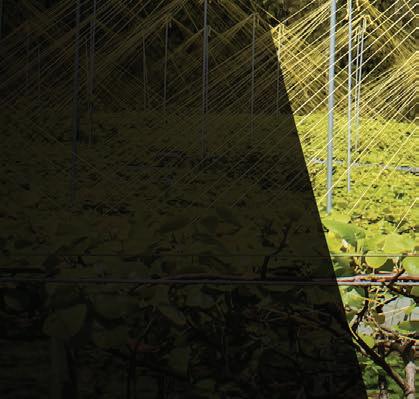


e 2020 season
“As we were classed as an essential food production business, we continued to work when the March 2020 lockdown was announced.
“We employ local workers, so the 2020 immigrant worker restrictions didn’t a ect us.”

Covid-19 brought in a whole raft of issues for the orchard industry. Outdoor workers are well spaced so it wasn’t hard to keep them apart, but processing and packhouse sta needed to be safely spaced and perspex barriers put up between them. is meant less operators working at one time, slowing production.
“Everyone was coming up with cunning plans to improvise and keep everything going as normally as possible, while adhering to government guidelines.”
Whitehall Fruitpackers was in the middle of a cool store build, which wasn’t considered essential by the government, despite being essential to their operation. Mark found the di erent interpretations of rules “frustrating”, but the cool store construction was resumed and nished eventually, and they “got through the season okay”.

Page 36 KIWIFRUIT
...continued
• High grade steel stringing poles, made in New Zealand • A bracket system simplifying the installation and removal of poles • Easy stringing with a loop head STRINGING POLES NOW AVAILABLE Call Mike 07 282 1538 | agsteel.co.nz Whenservicematters 0800HUME4UIhumepack.co.nz
Whitehall Fruitpackers CEO and co-founder Mark Gardiner, left, CFO and co-founder Robyn Gardiner with the rest of the Whitehall team Kristin Goodwin, Paul Gardiner, Katie McQuade, Miguel Peterle. Photos: Catherine Fry.
e 2021 season
While there was more normality in 2021, and restrictions were lighter, the industry was hit by labour shortages.
“It wasn’t just due to a lack of migrant and backpacker workers, but also a lack of local workers.
“We were just about okay, but the kiwifruit industry as a whole rallied around to get that year’s crop picked and packed.”
In 2021 a lot of fruit, such as apples, wasn’t harvested and there was considerable wastage due to labour shortages.
e 2022 season
Once again there was a severe shortage of workers in the orchard industry and a noticeable reluctance to be employed.
“Despite paying higher than the living wage, we still struggle to nd workers.”
Fruit storage quality issues started to appear across the
country and customer claims increased markedly, with fruit not storing well.
“It was a rush for the industry to get kiwifruit picked and fruit was being handled with less care. is resulted in numerous customer claims and Zespri pausing progress payments to its suppliers. e price of kiwifruit o shore dropped due to poor fruit quality complaints.”
A severe weather event on October 7, 2022, dealt an already struggling industry another blow. An unseasonal frost had Waikato orchard owners up all night using wind machines, pulse misting water protection, and helicopters to try and keep their orchards full of budding fruit vines above freezing point.
“Some orchards, especially berry orchards, su ered huge losses, which is devastating for the whole



industry. e kiwifruit industry was hit hard too, we estimate we lost 30 per cent of our kiwi crop for the 2023 season.”
e 2023 season
“ e demand for kiwifruit is still very high, with health experts and gurus promoting them so despite everything that has happened, the market for kiwifruit is still very strong.”
To mitigate the lack of workers for the 2023 season, many packhouses have been introducing automation.
“We have installed the latest technology in automation at considerable cost. It has halved the number of workers needed to run the packhouse, but the sta
operating it require a higher level of training and technical knowledge.”
While the automation ensures the smooth processing and packing operations, kiwifruit still need to be hand harvested and labour is required for that.


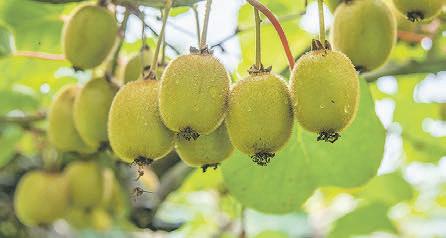
Mark is certainly noticing the rising cost of living and CPI increases.
“ e industry has to be realistic, the cost of everything we need is steadily increasing. Fertiliser, fuel, labour,











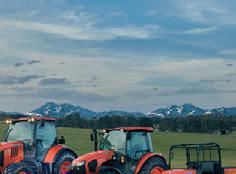
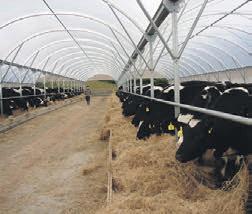
packaging and plant are all going up.
“Every time Putin does something, or there is a development in the Ukraine war, or another Covid-19 strain is identi ed, we quickly see that re ected in our business costs.”
Despite everything, the industry is forging ahead with orchard owners adapting their procedures throughout these tough times and managing the di culties placed in front of them.
MyNameisNeilWoodward.
IamadirectorofZ-Contracting-wearefamilyrun business,ourteamconsistsofthree,beingmyself,my sonandmybrother.
Ourorganisationhasbeenestablishedforover18 years.Ihavebeeninvolvedin applyingcropprotection programmeswithinthehorticultalindustrysince1966. Wespecialisewithinthekiwifruitindustry, We have theequipmenttosprayorchardswithour two Atomsprayers and one recently purchased Tracatom Formula tractor which is also available for mulching and mowing

MyNameisNeilWoodward
IamadirectorofZ-Contracting-wearefamilyrun business,ourteamconsistsofthree,beingmyself,my sonandmybrother.
Ourorganisationhasbeenestablishedforover18 years.Ihavebeeninvolvedin applyingcropprotection programmeswithinthehorticultalindustrysince1966.



Wespecialisewithinthekiwifruitindustry, We have theequipmenttosprayorchardswithour two Atomsprayers and one recently purchased Tracatom Formula tractor which is also available for mulching and mowing








Our Atoms aresetupwithradarspeedsensors,this combined with fullyautomated sprayer controllers and three nozzle ringsenhancesapplicationef ficiency and accuracy.
We also useaquadbikeforstripweedspray applications.




Weholdallcertificatesneededtomeet Globalgap compliance.
Welookatallchallengestohelpensureweprotect yourcropwithexcellence.

E-mail:zcl@zanadu.co.nz


Page 37 KIWIFRUIT
continued...
Kiwifruit vines.
e new automated packhouse at Whitehall Fruitpackers.
Catherine Fry
Checking sample kiwifruit leaves for scale.
Ou esetupwithradarspeedsensors,this useaquadbikeforstripweedspray Weholdallcertificatesneededtomeet
yourcropwithexcellence.
Phone:021907621 E-mail:zcl@zanadu.co.nz
TePuke
Welookatallchallengestohelpensureweprotect
Tocontactus:
216PongakawaBushRoad
KUBOTA.CO.NZ 4 Te Puke Quarry Road, Te Puke www.rrtractors.co.nz KUBOTA.CO.NZ 07 573 9107 4 Te Puke Quarry Road, Te Puke www.rrtractors.co.nz KUBOTA.CO.NZ 07 573 9107 4 Te Puke Quarry Road, Te Puke www.rrtractors.co.nz 1500kg lift capacity on the M7040SU Kubota loaders o er ample lifting height and capacity, ideal for demanding livestock farming a more productive and practical operation M7040 SUHDFRONT END LOADER 68HP E-CDIS engine 8-speed mechanical synchro shuttle 1500kg lift capacity on the M7040SU Kubota loaders o er ample lifting height and capacity, ideal for demanding livestock farming 8-speed mechanical synchro shuttle 1500kg lift capacity on the M7040SU Kubota loaders o er ample lifting height and capacity, ideal for demanding livestock farming Optional QVX36 Front End loader $13,139 Powerful performance with a 95HP, 4-cylinder Designed for heavy duty work and equipped with hydraulic shuttle, Creep Speed and Autohitch for a more productive and practical operation FROM $79,500 + GST 100-135HP common rail engine with massive torque 24-speed powershift transmission with auto Super-quiet deluxe cab Bi-speed turn that speeds up front wheels Available with narrow vineyard kit 5-year extend warranty 0.9%P.A. FINANCE FOR 36 MONTHS across the MGX Series FINANCE PROVIDED BY UDC FINANCE LIMITED 8-speed mechanical synchro shuttle 1500kg lift capacity on the M7040SU Kubota loaders o er ample lifting height and capacity, ideal for demanding livestock farming Optional QVX36 Front End loader $13,139 Powerful performance with a 95HP, 4-cylinder Designed for heavy duty work and equipped with hydraulic shuttle, Creep Speed and Autohitch for a more productive and practical operation MGX SERIES FROM $79,500 + GST 100-135HP common rail engine with massive torque 24-speed powershift transmission with auto Super-quiet deluxe cab Bi-speed that speeds up front wheels tight turns Available with narrow vineyard kit 5-year extend warranty 0.9%P.A. FINANCE FOR 36 MONTHS across the MGX Series FINANCE PROVIDED BY UDC FINANCE LIMITED M7040 SUHD - WITH QVX26 FRONT END LOADER 68HP E-CDIS engine 8-speed mechanical synchro shuttle 1500kg lift capacity on the M7040SU Kubota loaders o er ample lifting height and capacity, ideal for demanding livestock farming M9540 DH Optional QVX36 Front End loader $13,139 Powerful performance with a 95HP, 4-cylinder turbo charged engine Designed for heavy duty work and equipped with hydraulic shuttle, Creep Speed and Autohitch for a more productive and practical operation MGX SERIES FROM $79,500 + GST 100-135HP common rail engine with massive torque 24-speed powershift transmission with auto shift Super-quiet deluxe cab Bi-speed turn that speeds up front wheels for tight turns Available with narrow vineyard kit 5-year extend warranty 0.9%P.A. FINANCE FOR 36 MONTHS * across the MGX Series FINANCE PROVIDED BY UDC FINANCE LIMITED M7040 SUHD - WITH QVX26 FRONT END LOADER 68HP E-CDIS engine 8-speed mechanical synchro shuttle 1500kg lift capacity on the M7040SU Kubota loaders o er ample lifting height and capacity, ideal for demanding livestock farming M9540 DH Optional QVX36 Front End loader $13,139 Powerful performance with a 95HP, 4-cylinder turbo charged engine Designed for heavy duty work and equipped with hydraulic shuttle, Creep Speed and Autohitch for a more productive and practical operation MGX SERIES FROM $79,500 + GST 100-135HP common rail engine with massive torque 24-speed powershift transmission with auto shift Super-quiet deluxe cab Bi-speed turn that speeds up front wheels for tight turns Available with narrow vineyard kit 5-year extend warranty 0.9%P.A. FINANCE FOR 36 MONTHS * across the MGX Series FINANCE PROVIDED BY UDC FINANCE LIMITED
216PongakawaBushRoad
classified listings



curriculum vitae
CV’s THAT STAND OUT. Don’t let your C.V. get lost amongst all the others. Get the WOW factor. A C.V. For You can provide you with a personal and professional touch. From scratch or update existing ones. Check out samples on www. facebook.com/acvforyou or Ph/ text on 021 27 27 912.
LIST YOUR EVENT HERE!











March 11-12
March 23



March 26
March 31-April 1
for sale
PULLETS HY-LINE BROWN, great layers. Phone 07 824 1762 www.eurekapoultryfarm.weebly.com
* your listing *
DO YOU HAVE something to sell or looking to buy or promote your business? List it here for only $23 for up to 20 words. Email office@thesun.co.nz or call 07 578 0030.
professional services


email with ‘Rural Event’ in the subject line to: editor@ coastandcountrynews.co.nz























(must be under $50 or free)
All of March Government Gardens
Guided Tour, 11am, Rotorua, free, but please book. See: tinyurl.com/yz2y4wjb
March 5
All Ford Day,10am3pm, Wharepai Domain, Tauranga, $5. See tinyurl.com/ bdhja3kw Plant Sale, 10am-1pm, Te Puna Quarry Park (o SH2 near Tauranga), cash only.
E-waste Collection, 9-11am, 420 Albert Park Drive, Te Awamutu. See: urbanminers.nz/ collection-calendar
This is Kiwi Indigo Festival, 4-9pm, Hamilton Gardens, free. See: tinyurl.com/4rchjd5u
March 11
Free Composting Workshop, 2-3pm, Firth Tower, Matamata, free but please book a space. See : rthtower.co.nz/events
Mercury Bay Art Escape Open Studios, 10am-4pm. See: hmercurybay-artescape.com
March 12
Hamilton Dahlia Show, 12.303pm, Hamilton Gardens, $3.

Autumn Migration Day, Pūkorokoro Miranda Shorebird Centre, will include a speaker. High tide 11.20am. See: shorebirds.org.nz
E-waste Collection, 8.30am-1pm, Memorial Park, Cambridge. See: urbanminers.nz/ collection-calendar
March 17-19
Rotorua Walking Festival. See: rotoruawalkingfestival. org.nz
March 18
Tauranga Multicultural Festival, 10am-5pm, Historic Village, 17th Ave West, Tauranga, gold coin. See: tinyurl.com/ mv8pzn4e
March 19
E-waste Collection, 9-11am, Cambridge High School, Cambridge. See: urbanminers.nz/ collection-calendar
Waikato Horticultural Society AGM, 7.30pm, guest speaker Sally Sleigh on ‘Plants for Bees’, Wintec classroom, Hamilton Gardens (Gate 2), visitors $5. Ph Carmel: 07 855 3404.

March 23-April 2
Cambridge Autumn Festival. See: cambridgeautumnfestival. co.nz
March 24-April 2
Flavours of Plenty Festival, Bay of Plenty. See: avoursofplentyfestival. com
March 25 Home
Composting Workshop, 1.30pm, Turangi & Taupo, free. Repeated monthly until June. See: tinyurl.com/zsvdvub
Wild Food Festival, 10am-4pm, Port Ōhope (near Whakatāne), $15 (under 18 free). See: tinyurl.com/3xvuf6se
Biochar Workshop, 3.30-5.30pm, Katikati, $15. Email: growonkatikati@gmail. com to book and for venue.


The Great Pumpkin Carnival, 10am-2pm, Hamilton Gardens, free. See: tinyurl.com/2p824whn
March 27

Get Started with Microgreens, 1-2.30pm, Envirohub, 31B Glasgow Street, Tauranga, $10. See: tinyurl.com/wmtdhwpr


March 28 & 30
Behind the Scenes with Bee NZ, 11.30am-12.30pm, 85 Tetley Rd, Katikati, $16.
March 28
Solomons Gold Chocolate Factory Tour, 2-2.30pm, 1 Macrae Avenue, Mount Maunganui, $20. See: tinyurl.com/3e3ybv5x
March 30
Food for Thought
Discussion, 6.309.30pm, e General Cafe, 19B Paci c Avenue, Mount Maunganui, $49. See: tinyurl.com/2umnp7eb
March 31
Scion 75th Anniversary Photo Exhibition, Long Mile Rd, Rotorua, free.
BOP Orchid Show, Memorial Hall, Te Puke. Ph Faye: 07 573 9710.

April 1
Crop Swap, 9.30am-10.30am, 45 Beach Rd, Katikati. Ph: 07 549 2337.

Waikato-BOP Tree Climbing Champs, Wharepai Domain, Tauranga. See: tinyurl.com/yv8jaty4
April 1-16
Echo Walking Festival, Waikato, Coromandel & Western Bay of Plenty. See echowalkfest.org.nz
April 2
E-waste Collection, 9-11am, 420 Albert Park Drive, Te Awamutu. See: urbanminers.nz/ collection-calendar
April 1-10
National Jazz Festival, Tauranga. Se:e jazz.org.nz
April 10
Edible Weeds & Green Smoothies, 10am2pm, Greerton, Tauranga, $85. See: juliasedibleweeds.com
Check out the auto extravaganza!


After a setback from Cyclone Gabrielle - Tauranga’s Auto Extravaganza is set for Sunday, March 12, on e Strand in Tauranga from 9am to 2pm.



It will feature the most amazing bikes, cars, and trucks from around the country. With hot wheels, hot food, good music and spot prizes there’s no better way to spend a Sunday!
All proceeds will be handed over to St John, and managed by the Welcome Bay Lions Club. With a two year hiatus due to Covid-19, joint convener Neville McKay says the show will be back “better than ever”.

“We’re excited to see people come down for a good cause.
“Spot prizes, like Repco and Countdown vouchers, will be handed out thanks to our sponsors.” Attendees can also look forward to seeing the “A Girls” 1930s Ford Model A Coupe which will be on display, along with a range of other stunning vehicles sure to please curious spectators and petrol heads alike. A gold coin donation/koha per person would be much appreciated on entry.
Show vehicles are $5 per entry.

Page 38 COAST & COUNTRY NEWS
Leith and Lisa Sawyer with the stunning 1930 Ford Model A Coupe.
Photo: John Borren.














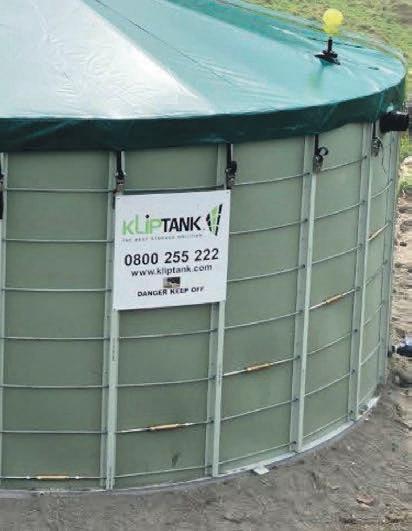




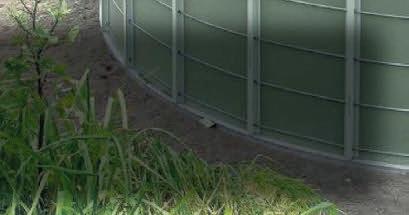


Page 39 COAST & COUNTRY NEWS www.kliptank.com - 0800 255 222 •6 sizes ranging from 70,000 - 190,000 Litres •25-year design life •Small footprint. 6.9m or 9.2m diameter •Sand foundation. No concrete required •Simple at pack for cartage – remote sites •2 people, 2 days to install. Or get our team to install for you (charges apply) •Minimal pipework and connections •Lifestyle TankTM optional accessories available TM Available now! From $19,995 ALL NEW
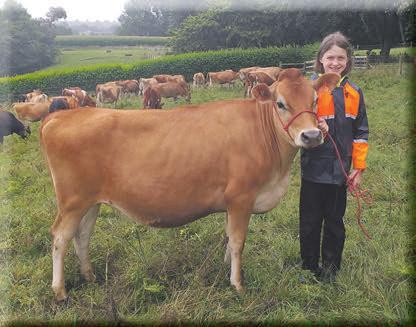


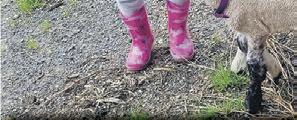
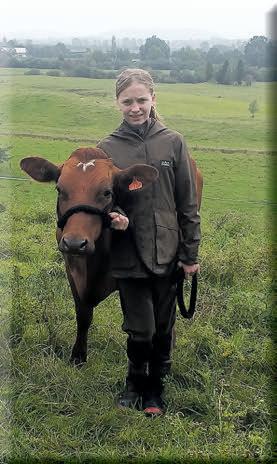









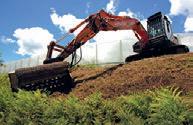






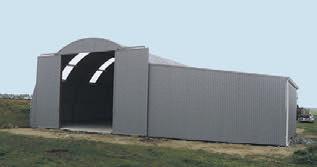



Page 40 COAST & COUNTRY NEWS
Rebecca Turner, 11, with her heifer Louise in Te Awamutu.
Below: Caitlyn Turner, 13, with her heifer Katie in Te Awamutu.
Brianna Farrelly, 3, feeding her orphan lambs in Matamata.























































































































































































































































































































































































































































































































































































































































































































































































































































